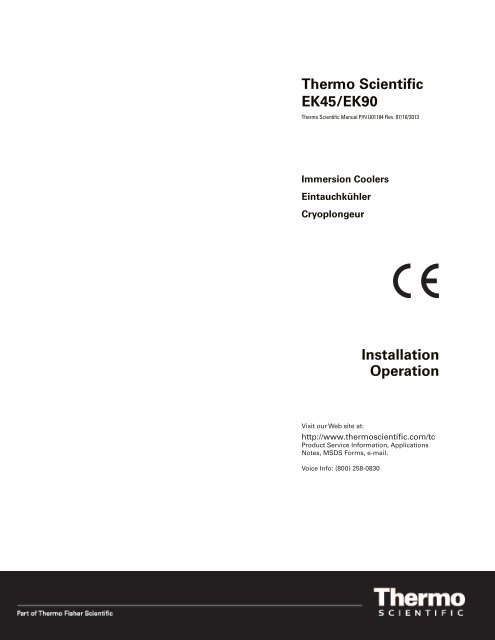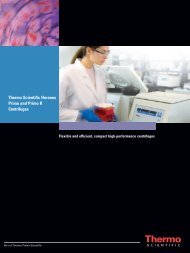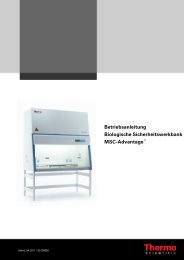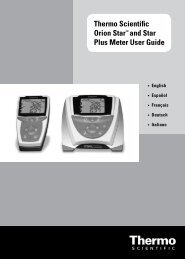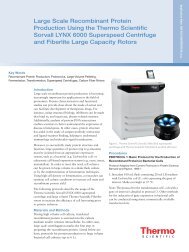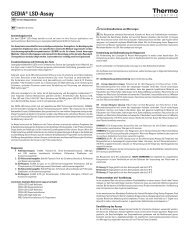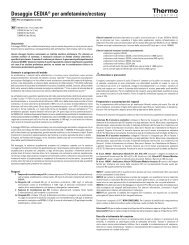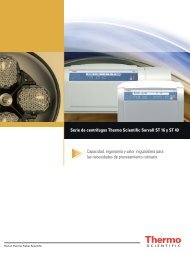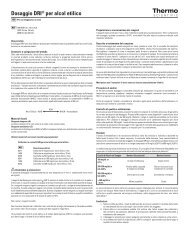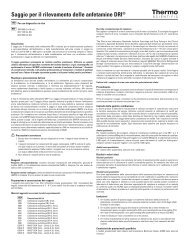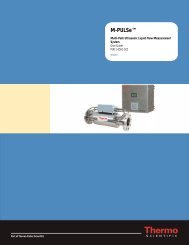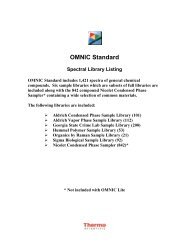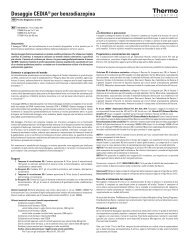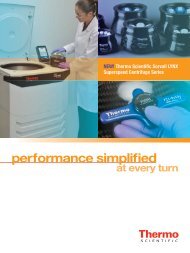Thermo Scientific EK45/EK90 Installation Operation - Fisher Scientific
Thermo Scientific EK45/EK90 Installation Operation - Fisher Scientific
Thermo Scientific EK45/EK90 Installation Operation - Fisher Scientific
Create successful ePaper yourself
Turn your PDF publications into a flip-book with our unique Google optimized e-Paper software.
<strong>Thermo</strong> <strong>Scientific</strong><strong>EK45</strong>/<strong>EK90</strong><strong>Thermo</strong> <strong>Scientific</strong> Manual P/N U01184 Rev. 07/10/2013Immersion CoolersEintauchkühlerCryoplongeur<strong>Installation</strong><strong>Operation</strong>Visit our Web site at:http://www.thermoscientific.com/tcProduct Service Information, ApplicationsNotes, MSDS Forms, e-mail.Voice Info: (800) 258-0830
<strong>Thermo</strong> <strong>Scientific</strong><strong>EK45</strong>/<strong>EK90</strong><strong>Thermo</strong> <strong>Scientific</strong> Manual P/N U01184 Rev. 07/10/2013Immersion CoolersEintauchkühlerCryoplongeur<strong>Installation</strong><strong>Operation</strong>Visit our Web site at:http://www.thermoscientific.com/tcProduct Service Information, ApplicationsNotes, MSDS Forms, e-mail.Voice Info: (800) 258-0830
<strong>Thermo</strong> <strong>Fisher</strong> <strong>Scientific</strong>25 Nimble Hill RoadNewington, NH 03801Tel : (800) 258-0830 or(603) 436-9444Fax : (603) 436-8411www.thermoscientific.com/tcSales, Service, and Customer Support25 Nimble Hill RoadNewington, NH 03801Tel: (800) 258-0830Sales: 8:00 am to 5:00 pmService and Support: 8:00 am to 6:00 pmMonday through Friday (Eastern Time)Fax: (603) 436-8411service.tc.us@thermofisher.comDieselstrasse 4D-76227 Karlsruhe, GermanyTel : +49 (0) 721 4094 444Fax : +49 (0) 721 4094 300info.tc.de@thermofisher.comBuilding 6, No. 27Xin Jinqiao Rd., Shanghai 201206Tel : +86(21) 68654588Fax : +86(21) 64457830info.china@thermofisher.comStafford House1 Boundary ParkHemel Hempstead, Hertfordshire HP2 7GEUnited KingdomPhone: +44 (0)8706 099254Fax: +44 (0)1606 548103Statement of CopyrightCopyright © 2013 <strong>Thermo</strong> <strong>Fisher</strong> <strong>Scientific</strong>. All rights reserved.This manual is copyrighted by <strong>Thermo</strong> <strong>Fisher</strong> <strong>Scientific</strong>.Users are forbidden to reproduce, republish, redistribute, or resell any materials from this manual in either machinereadableform or any other form.
PrefaceSection 1Section 2Section 3Table of Contents....................................................................................................................... iCompliance...............................................................................................................iWEEE Compliance................................................................................................iAfter-Sale Support..................................................................................................iiFeedback..................................................................................................................iiWarranty...................................................................................................................iiUnpacking................................................................................................................iiDeclaration of Conformity..................................................................................iiiSafety...................................................................................1-1Safety Warnings..................................................................................................1-1Personal Protective Equipment........................................................................1-2Training................................................................................................................1-2General Information................................................................2-1Description and Intended Use.........................................................................2-1Specifications/Equipment Ratings..................................................................2-2<strong>Installation</strong>............................................................................3-1Ventilation...........................................................................................................3-1Electrical Requirements.....................................................................................3-1Fuses.....................................................................................................................3-2Temperature Sensor...........................................................................................3-2Tube and Coil......................................................................................................3-2Mounting Accessory (<strong>EK45</strong> only) ..................................................................3-2Fluid Considerations..........................................................................................3-3Approved Fluids.................................................................................................3-3Shipping/Storage................................................................................................3-4Decommissioning/Disposal.............................................................................3-4Section 4 <strong>Operation</strong> .............................................................................4-1Controller............................................................................................................4-1Setup.....................................................................................................................4-2Start Up Shut Down..........................................................................................4-2<strong>Thermo</strong> <strong>Scientific</strong>
ContentsSection 5Preventive Maintenance..........................................................5-1Cleaning ...........................................................................................................5-1Evaporator Coil..................................................................................................5-1Condenser ...........................................................................................................5-1Fluid Maintenance..............................................................................................5-1Section 6 Troubleshooting............................................................................................... 6-1Error Displays.....................................................................................................6-1Check List ...........................................................................................................6-2Warranty<strong>Thermo</strong> <strong>Scientific</strong>
PrefaceCompliance Refer to the Declaration of Conformity in this manual.WEEE ComplianceThis product is required to comply with the European Union’s WasteElectrical & Electronic Equipment (WEEE) Directive 2002/96/EC. It ismarked with the following symbol:<strong>Thermo</strong> <strong>Fisher</strong> <strong>Scientific</strong> has contracted with one or more recycling/disposal companies in each EU Member State, and this product should bedisposed of or recycled through them.Further information on <strong>Thermo</strong> <strong>Fisher</strong> <strong>Scientific</strong> compliance with theseDirectives, the recyclers in your country, and information on <strong>Thermo</strong><strong>Fisher</strong> <strong>Scientific</strong> products which may assist the detection of substancessubject to the RoHS Directive are available at www.thermofisher.com/WEEERoHSAfter-sale Support<strong>Thermo</strong> <strong>Fisher</strong> <strong>Scientific</strong> is committed to customer service both duringand after the sale. If you have questions concerning the cooler operation,or questions concerning spare parts or Service Contracts, call our Sales,Service and Customer Support phone number, see this manual's insidecover for contact information.VACSample NameplateBefore calling, please obtain the serial number printed on the nameplatelocated on the upper rear of the cooler.<strong>Thermo</strong> <strong>Scientific</strong>i
PrefaceFeedbackWarrantyWe appreciate any feedback you can give us on this manual. Please e-mailus at tcmanuals@thermofisher.com. Be sure to include the manual partnumber and the revision date listed on the front cover.<strong>Thermo</strong> <strong>Scientific</strong> Immersion Coolers have a warranty against defectiveparts and workmanship for 24 months from date of shipment. See backpage of this manual for more details.Unpacking Retain all cartons and packing material until the cooler is operated andfound to be in good condition. If the cooler shows external or internaldamage contact the transportation company and file a damage claim.Under ICC regulations, this is your responsibility.CAUTIONTake into account its weight when unpacking and transporting. Werecommend two people lift the cooler. NOTE Leave coolers in an upright position at room temperature (~25°C)for 24 hours before starting. This will ensure the lubrication oil has drainedback into the compressor. ii<strong>Thermo</strong> <strong>Scientific</strong>
Laboratory Equipment Div.25 Nimble Hill RoadNewington, NH 03801DECLARATION OF CONFORMITYManufacturer:Address:<strong>Thermo</strong> <strong>Fisher</strong> <strong>Scientific</strong>25 Nimble Hill RoadNewington, NH USA 03801 Year of inception 2012Products: EK Immersion Coolers.We declare that the following products conform to the Directives and Standards listed below:<strong>Thermo</strong> <strong>Fisher</strong> <strong>Scientific</strong> EK models 20, 30, 45 and 90.All rated :1. 115 Volts, 60 Hz or2. 208-230 Volts, 60 Hz or3. 230 Volts, 50 HzEquipment Class: Measurement, control and laboratoryDirectives and Standards:2004/108/EC – Electromagnetic Compatibility ( EMC Directive ):EN 61326-1: 2006 – Electrical equipment for measurement, control, and laboratory useEMC requirements, EMC Class A2006/95/EC – Low Voltage Directive ( LVD ):EN 61010-1: 2004 – Safety requirements for electrical equipment for measurement,control, and laboratory use – general requirements.Manufacturer’s Authorized RepresentativeDate11 Jan 2012D of C 097025.1 Form 094233-PDWG # 097025 REV 14 Sept 11
Safety WarningsDANGERWARNINGCAUTIONSection 1 SafetyMake sure you read and understand all instructions and safety precautionslisted in this manual before installing or operating your cooler. If you haveany questions concerning the operation of your cooler or the informationin this manual, please contact us. See inside cover for contact information.DANGER indicates an imminently hazardous situation which, if notavoided, will result in death or serious injury.WARNING indicates a potentially hazardous situation which, if notavoided, could result in death or serious injury.CAUTION indicates a potentially hazardous situation which, if notavoided, may result in minor or moderate injury. It is also be used to alertagainst unsafe practices.The lightning flash with arrow symbol, within an equilateral triangle, isintended to alert the user to the presence of non-insulated "dangerousvoltage" within the cooler's enclosure. The voltage magnitude is significantenough to constitute a risk of electrical shock.This label indicates read the manual.NOTE The cooler's equipment design incorporates a complete sheet metalenclosure for personnel protection from mechanical and electrical hazards. Observe all warning labels. Never remove warning labels. Use the cooler solely for the intended application. Do not operated inrooms used for medical purposes and/or in the vicinity of patients. The cooler construction provides protection against the riskof electrical shock by grounding appropriate metal parts. Theprotection will not function unless the power cord is connected to aproperly grounded outlet. It is the user's responsibility to assure aproper ground connection is provided. Operate the cooler using only the supplied line cords, never operateequipment with damaged cords. Ensure all electrical connections are made prior to starting thecooler. <strong>Thermo</strong> <strong>Scientific</strong>1-1
Section 1 SafetyAlways turn the cooler off and disconnect the supply voltage from itspower source before moving performing any service or maintenanceprocedures. Ensure cooler is at a safe temperature before handling. Never place the cooler in a location or atmosphere where excessive heat,moisture, or corrosive materials are present. Leave cooler in an upright position at room temperature (~25°C) for 24hours before starting. This will ensure the lubrication oil has drainedback into the compressor. Other than water, before using any fluid, or when performing maintenancewhere contact with the fluid is likely, refer to the manufacturer’sMSDS and EC Safety Data sheet for handling precautions. The cooler's evaporator coil must not be kinked, bent or twisted. Thiscan lead to evaporator coil damage and a refrigeration leakage. Ensure, that no toxic gases can be generated by the fluid. Flammablegases can build up over the fluid during usage. Never use corrosive or flammable fluids with this cooler. Use of thesefluids will void the manufacturer’s warranty. Never operate the cooler with panels removed. Transport the cooler with care. Sudden jolts or drops can damage itscomponents. Do not clean the cooler with solvents, only use a soft cloth and water. Refer service and repairs to a qualified technician. Performance of installation, operation, or maintenance procedures otherthan those described in this manual may result in a hazardous situationand will void the manufacturer's warranty. Personal ProtectiveEquipmentThe are no special personal protective equipment requirements needed toperform normal operation. We do recommend wearing eye protection andgloves.TrainingThe user must review and understand all the sections in this manual beforeoperating the cooler.1-2<strong>Thermo</strong> <strong>Scientific</strong>
Section 2 General InformationDescriptionand IntendedUseThe <strong>EK45</strong> Immersion Cooler has a one-stage refrigerating circuit. The coolantcircuit’s evaporator coil, shaped as spiral-shaped cooling element, connects to thecooling unit with a flexible, specially heat-insulated hose. It can be immersed in avessel with an inner diameter of >85 mm and a depth of >200 mm. The coolingunit compressor is air-cooled and fully hermetically sealed.The <strong>EK90</strong> has a two-stage refrigerating circuit. The cooling element is a flexiblecorrugated coil and can be bent to the desired vessel. The inner diameter of thevessel cannot be smaller than 110 mm (2 x the smallest bending radius of 40 mm= 80 mm plus 2 x the diameter of the corrugated coil at 13 mm = 26 mm). Thevessel depth can be as small as 100 mm. These are the minimum dimensions forthe cooling element however frequent bending with very small radii can damage thecorrugated coil. If multiple bends are necessary a minimum diameter of at least 250mm (bending radius of 110 mm) is required.Both units are equipped with a built-in temperature controller with a red LEDdisplay.A temperature stability of approximately 1°C to 2°C is possible. Any temperaturewithin the working temperature range can be set, see next page. A heater is necessaryfor applications requiring temperatures above the ambient temperature.The temperature controller features the display of the actual temperature, thesetpoint temperature and a control status display.Both are supplied with a Pt100 temperature sensor. The sensor is monitored forbreakage and short-circuiting. The sensor should be located in the bath in the directvicinity of the cooler's evaporator coil.Cooling is done using heat exchangers that draw off and expel the heat. The coolingcapacity depends to a great extent on the free flow of cooling air through the twoventilation grids. These grids (one at the front and one at the rear side) must be keptfree of all obstacles at all times!<strong>Thermo</strong> <strong>Scientific</strong>2-1
Section 2 General InformationSpecifications/Equipment Ratings<strong>EK45</strong><strong>EK90</strong>Working Temperature -45°C to +40°C -90°C to +40°CRange 1 -49°F to +104°F -130°F to +104°FAmbient Temperature +10°C to +40°C +10°C to +40°CRange 2 +50°F to +104°F +50°F to +104°FMaximum Relative Humidity 80%/31°C to 50%/40°C 80%/31°C to 50%/40°C(Non Condensing)Operating Altitude Sea Level to 2000 meters (6560 feet) Sea Level to 2000 meters (6560 feet)Pollution Degree 2 2Overvoltage Category II IIDegree of Protection IP20 IP20Sound Level 3 less than 58 dBA less than 58 dBACooling Capacity at +20°C 350 watts 300 wattsat -10°C 250 watts 280 wattsat -40°C - 170 wattsat -60°C - 100 wattsCompressor Cooling Air AirRefrigerant R404A (4.3 ounces) R404A (5.7 ounces)/R23 (115 PSIG)Hose Length 150 cm 150 cmCooling Coil (Ø x L) 81 x195 mm 13 x 900 mmSmallest Bending Radius 4 - 40mmCooler Dimensions (H x W x D) 380 x 225 x 465 mm 490 x 380 x 460 mmEvaporator Material 300 Series Stainless Steel 300 Series Stainless SteelNominal Weight kg/lb 27.2 / 60.0 62.7 / 138.2Electrical Requirements 5 230V/50Hz or 230V/50Hz or115V/60Hz115V/60HzTotal Maximum Wattage 900VA 1300VA1. The lowest possible temperature in a bath and the shortest cooling down time are dependent on: thevolume of liquid to be cooled, the type of liquid and its viscosity at the desired working temperature,the heat conductivity of the liquid, the bath vessel and covering insulation, the heat created by anyunit immersed in the bath used to recirculate or stir the liquid.The lowest temperatures possible for the <strong>EK45</strong> and <strong>EK90</strong> specified above were reached in a Dewarvessel with a volume of 2 liters. Methylcyclohexane was used as the bath liquid and the bath was notstirred.2. The cooling capacity is reduced at ambient temperatures of > 30°C.3. 1 meter from unit.4. Never bend the probe when it is cold.5. Nominal values ±10%.• <strong>Thermo</strong> <strong>Fisher</strong> <strong>Scientific</strong> reserves the right to change specifications without notice.2-2 <strong>Thermo</strong> <strong>Scientific</strong>
Section 2 General Information<strong>EK45</strong>Front ViewConnection Hose(1.5 meters)Rear ViewTemperatureControllerFusesPt100 SensorCircuit protectorNameplatePower SupplyVentilation Grid(Suction Side)Ventilation Grid(Exhaust Side)Evaporator Coil<strong>Thermo</strong> <strong>Scientific</strong>2-3
Section 2 General Information<strong>EK90</strong>Front ViewRear ViewConnection Hose(1.5 meters)Pt100 SensorReset KeyFault MonitorTemperatureControllerCircuitprotectorNameplateEvaporator CoilFusesVentilation Grid(Suction Side)Power SupplyVentilation Grid(Exhaust Side)2-4 <strong>Thermo</strong> <strong>Scientific</strong>
Section 3 <strong>Installation</strong>The immersion circulator is designed for continuous operation and forindoor use.CAUTIONCAUTIONNever place the cooler in a location where excessive heat, moisture,inadequate ventilation, or corrosive materials are present. Leave coolers in an upright position at room temperature (~25°C) for24 hours before starting. This will ensure the lubrication oil has drainedback into the compressor. VentilationElectricalRequirementsDANGERThe cooler requires clean air for proper operation. Air enters from the frontand exits through the rearThe cooler construction provides protection against the risk ofelectrical shock by grounding appropriate metal parts. The protectionwill not function unless the power cord is connected to a properlygrounded outlet. It is the user's responsibility to assure a properground connection is provided. The cooler is intended for use on a dedicated outlet.CAUTIONThe cooler's power cord is the electrical disconnecting device, it mustbe easily accessible at all times. Operate the cooler using only the supplied line cords, never operateequipment with damaged cords. Refer to the nameplate on the rear of the cooler for specific electricalrequirements. Voltage range deviations of ± 10% are permissible. The outletmust be rated as suitable for the total power consumption of the cooler.CAUTIONEnsure the electrical cords do not come in contact with the evaporatorcoil or hose. <strong>Thermo</strong> <strong>Scientific</strong>3-1
Section 3 <strong>Installation</strong>FusesAll units are equipped with automatic thermally-triggered fuses. A redmarking indicates a triggered fuse. Allow the unit to cool, approximately fiveminutes, before pressing the fuse reset on the rear of the unit.If the fuse triggers again the cooler has a defect. Contact our CustomerService and Support.Temperature SensorThe Pt100 sensor should be located in the bath in thedirect vicinity of the evaporator coil.A temperature accuracy of approximately 1 to 2°C ispossible. Any temperature within the working temperaturerange can be set. A heater is necessary for applicationswhich require temperatures above the respective ambient2temperature. 1Ω34Tube and CoilCAUTIONNever sharply bend the evaporator tube and coil or form it into a smallradius. Damage caused by an excessive bending of the cooling coil is not covered byour warranty.Evaporator hose − the smallest permissible bending radius is 125 mm.Evaporator coil (cooling coil) − the smallest permissible bending radius forthe <strong>EK90</strong> is 40 mm (one bend), or 110 mm (more than one bend).MountingAccessory(<strong>EK45</strong> only)To fit the evaporator in the optional clamping bracketslide the metal plates supplied with the bracket intothe slot above the evaporator coil.Insert the cooling element through the rectangularopeningAttach the inserted plates using four screws.CAUTIONDo not kink the evaporator hose. 3-2 <strong>Thermo</strong> <strong>Scientific</strong>
Section 3 <strong>Installation</strong>Fluid ConsiderationsDANGERCAUTIONOnly use the approved fluids listed below. Never use corrosive orflammable fluids with this cooler. Handle and dispose all liquids in accordance with the fluidmanufacturers specification and/or the MSDS for the fluid used. <strong>Fisher</strong> <strong>Scientific</strong> takes no responsibility for damages caused by theselection of an unsuitable fluid.Unsuitable bath fluids are fluids which:• are very highly viscous (much higher than 30 mPas at the respectiveworking temperature) or• have corrosive characteristics orFor fluid selection consider application requirements, operatingtemperature range, material compatibility, safety concerns, andenvironmental issues.Approved Fluids-10°C to 40°C — 50/50 Water with Laboratory Grade Ethylene GlycolBelow 5°C water has to be mixed with a glycol. The amount of glycoladded should cover a temperature range 5°C lower than the operatingtemperature of the particular application. This will prevent the water/glycol from gelling (freezing) near the evaporating coil.50% ethylene glycol is the maximum recommendation. Excess glycoldeteriorates the temperature accuracy due to its high viscosity.-50°C to 40°C — Synth 60 Synthetic heat transfer liquids are hygroscopicand require frequent changing.-70°C to 40°C — SIL 100 This liquid has very long term stability. Due tothe high viscosity at low temperatures we recommend using a stirrer.CAUTION<strong>Fisher</strong> <strong>Scientific</strong> heat transfer fluids are supplied with an EC Safety DataSheet.Ensure, when selecting the heat transfer fluid, that no toxic gasescan be generated. Inflammable gases can build up over the fluidduring usage. <strong>Thermo</strong> <strong>Scientific</strong>3-3
Section 3 <strong>Installation</strong>Shipment/StorageDecommissioning/DisposalCAUTIONDo not store the cooler below -20°C, and
Section 4 <strong>Operation</strong>Controller°CSETThe controller displays the current sensor temperature.To view the setpoint press the SET key. The change the setpoint press andhold the SET key for two seconds. Use the key to raise or the keyto lower the displayed setpoint value. Press the SET key again to store anddisplay the new setpoint value. The controller automatically displays to currenttemperature.NOTE If no entry is made within three seconds the value shown in the displayautomatically switches back to the current temperature and the controllerreturns to the previous setpoint value. EK 90 onlyFault display light illuminates to indicate a fault has occurred.Reset button resets the cooler after a fault or interruption.<strong>Thermo</strong> <strong>Scientific</strong>4-1
Section 4 <strong>Operation</strong>SetupCAUTIONLeave the cooler in an upright position at room temperature(~25°C) for 24 hours before starting. This will ensure the lubricationoil has drained back into the compressor. Immerse the cooling coil (evaporator) of the cooler into a suitablebath vessel. The coil must be completely covered with liquid otherwiseice will form.Start UpShut Down• To start the cooler place the circuit protector located on thefront of the cooler to the I position.NOTE If the cooler is started in poor environmental conditions,the pressure safety device may respond after approximately one minuteand shut down the unit. Press the reset button. If fault reoccursseveral times contact our Customer Service and Support. Once the unit is turned on, the refrigeration system will reducethe temperature of the cooling fluid in the work area to the lowestachievable temperature under the existing heat load conditions.For best results we recommend stirring or agitation in the work area.When not stirred, cooling capacities will be reduced and the workarea will show temperature layering, with the coldest, most densezone at the bottom.• To stop the cooler place the circuit protector located on thefront of the cooler to the O position.When the unit is shut off, wait approximately five minutes beforerestarting. This allows time for the refrigeration pressures to equalize.If the pressures are not allowed to equalize, the compressor willshort-cycle (clicking sound) and no cooling will occur.4-2 <strong>Thermo</strong> <strong>Scientific</strong>
CAUTIONCAUTIONCleaningEvaporator CoilCondenserSection 5 Preventive MaintenanceDisconnect the power cord prior to performing any maintenance. Handle the cooler with care. Sudden jolts or drops can damage itscomponents. There are no user serviceable components within the cooler's cabinet. Only<strong>Thermo</strong> <strong>Fisher</strong> should provide any required replacement parts.Clean the cooler's surface with a soft cloth and warm water only.Quickly remove substances containing acidic or alkaline substances and metalshavings. They will harm the surfaces and could cause corrosion.For proper operation, the cooler needs to pull air through a condenser. Abuild up of dust or debris on the fins of the condenser will lead to a loss ofcooling capacity.On <strong>EK90</strong>s remove the front grid panel by turning the four mounting screws90°. To replace the grid push in on the screws, do not rotate them.Use a brush, or if necessary compressed air, to clean the condenser fins.The frequency of cleaning depends on the operating environment. Werecommend making a monthly visual inspection of the condenser after initialinstallation. After several months, the cleaning frequency will be established.Fluid MaintenanceThe cooling fluid in the work area should be periodically replaced whenoperating at low temperatures. At low temperatures, the cooling fluid maycollect water vapor from the air. As the concentration of water in the coolingfluid increases, performance is adversely affected.<strong>Thermo</strong> <strong>Scientific</strong>5-1
Section 6 TroubleshootingError DisplaysPFo No sensor is connected or the connected sensor is broken. The unitcools down to the lowest possible temperature.PFc The connected sensor has a short circuit. The unit cools down to thelowest possible temperature.In case of thermal overload the compressor the compressor shuts down. Thecompressor restarts automatically after it has cooled down.Possible causes for the compressor shutting down:• high ambient temperature• poor air quantity for cooling• compressor needs cleaning, or is defective• refrigerant leak in the 1st stage of the cooling circuitTo easily check the cooling air flow rate place a sheet of paper on theventilator grid suction side when the cooler is in use. The paper shouldadhere to the grid.NOTE For <strong>EK90</strong>s, after the fault has been eliminated the reset key must bepressed before restarting the unit. <strong>Thermo</strong> <strong>Scientific</strong>6-1
Section 6 TroubleshootingChecklistCooler will not startCheck the controller for error codes, see Error Codes in this section.Ensure the circuit protector is in the on ( I ) position.Make sure supply voltage is connected and matches the cooler's nameplaterating ±10%.No display on controllerCycle the circuit protector on the front of the cooler.Inadequate temperature controlVerify the setpoint.Check for ice build up on the cooling probe. A layer of ice will act as insulationand reduce the cooling capacity. Ice build up is often an indication that thecooling fluid needs replacing. Defrost the cooling probe and change the coolingfluid.Make sure the condenser is free of dust and debris.Ensure cooler installation complies with the site requirements in Sections 2 and 3.Make sure supply voltage matches the cooler's nameplate rating ±10%.If the temperature continues to rise, make sure your application's heat load doesnot exceed the rated specifications.Check for high thermal gradients (e.g., the application load is being turned onand off or rapidly changing).Cooler shuts downEnsure the circuit protector is in the on ( I ) position.Check the controller for error codes.Make sure supply voltage is connected and matches the cooler's nameplaterating ±10%.When the unit is shut off, wait approximately five minutes before restartingThis allows time for the refrigeration pressures to equalize. If the pressures arenot allowed to equalize, the compressor will short-cycle.Please contact <strong>Thermo</strong> <strong>Fisher</strong> <strong>Scientific</strong> Sales Service and Customer Support if youneed any additional information, see inside cover for contact instructions.6-2<strong>Thermo</strong> <strong>Scientific</strong>
WARRANTY<strong>Thermo</strong> <strong>Fisher</strong> <strong>Scientific</strong> warrants for 24 months from date of shipment the <strong>Thermo</strong> <strong>Scientific</strong> product accordingto the following terms.Any part of the unit manufactured or supplied by <strong>Thermo</strong> <strong>Fisher</strong> and found in the reasonable judgment of<strong>Thermo</strong> <strong>Fisher</strong> to be defective in material or workmanship will be repaired at an authorized <strong>Thermo</strong> <strong>Scientific</strong>Product Repair Depot without charge for parts or labor. The unit, including any defective part must be returnedto an authorized <strong>Thermo</strong> <strong>Scientific</strong> Product Repair Depot within the warranty period. The expense of returningthe unit to the authorized <strong>Thermo</strong> <strong>Scientific</strong> Product Repair Depot for warranty service will be paid for by thebuyer. Our responsibility in respect to warranty claims is limited to performing the required repairs or replacements,and no claim of breach of warranty shall be cause for cancellation or recision of the contract of salesof any unit. With respect to units that qualify for field service repairs, <strong>Thermo</strong> <strong>Fisher</strong> <strong>Scientific</strong>’s responsibilityis limited to the component parts necessary for the repair and the labor that is required on site to perform therepair. Any travel labor or mileage charges are the financial responsibility of the buyer.The buyer shall be responsible for any evaluation or warranty service call (including labor charges) if no defectsare found with the <strong>Thermo</strong> <strong>Scientific</strong> product.This warranty does not cover any unit that has been subject to misuse, neglect, or accident. This warrantydoes not apply to any damage to the unit that is the result of improper installation or maintenance, or to anyunit that has been operated or maintained in any way contrary to the operating or maintenance instructionsspecified in this Instruction and <strong>Operation</strong> Manual. This warranty does not cover any unit that has been alteredor modified so as to change its intended use.In addition, this warranty does not extend to repairs made by the use of parts, accessories, or fluids which areeither incompatible with the unit or adversely affect its operation, performance, or durability.<strong>Thermo</strong> <strong>Fisher</strong> <strong>Scientific</strong> reserves the right to change or improve the design of any product without assumingany obligation to modify any unit previously manufactured.THE FOREGOING EXPRESS WARRANTY IS IN LIEU OF ALL OTHER WARRANTIES, EXPRESSED ORIMPLIED, INCLUDING BUT NOT LIMITED TO WARRANTIES OR MERCHANTABILITY AND FITNESS FORA PARTICULAR PURPOSE.<strong>Thermo</strong> <strong>Fisher</strong> <strong>Scientific</strong>'s OBLIGATION UNDER THIS WARRANTY IS STRICTLY AND EXCLUSIVELYLIMITED TO THE REPAIR OR REPLACEMENT OF DEFECTIVE COMPONENT PARTS AND <strong>Thermo</strong> <strong>Fisher</strong>DOES NOT ASSUME OR AUTHORIZE ANYONE TO ASSUME FOR IT ANY OTHER OBLIGATION.<strong>Thermo</strong> <strong>Fisher</strong> ASSUMES NO RESPONSIBILITY FOR INCIDENTAL, CONSEQUENTIAL, OR OTHER DAM-AGES INCLUDING, BUT NOT LIMITED TO LOSS OR DAMAGE TO PROPERTY, LOSS OF PROFITS ORREVENUE, LOSS OF THE UNIT, LOSS OF TIME, OR INCONVENIENCE.This warranty applies to units sold in the United States. Any units sold elsewhere are warranted by the affiliatedmarketing company of <strong>Thermo</strong> <strong>Fisher</strong> <strong>Scientific</strong>. This warranty and all matters arising pursuant to it shall begoverned by the law of the State of New Hampshire, United States. All legal actions brought in relation heretoshall be filed in the appropriate state or federal courts in New Hampshire, unless waived by <strong>Thermo</strong> <strong>Fisher</strong><strong>Scientific</strong>.
Inhaltsverzeichnis1. Erläuterung der Symbole ........................................................ 31.1 In der Betriebsanleitung verwendete Symbole......................... 31.2 Am Gerät verwendete Symbole................................................ 32 WEEE Konformität .................................................................... 43. Sicherheitshinweise ................................................................ 54. Zubehör / Technische Daten.................................................... 74.1 Sicherungswerte....................................................................... 75. Gerätebeschreibung................................................................. 95.1 Eintauchkühler <strong>EK45</strong>................................................................ 95.2 Eintauchkühler <strong>EK90</strong>............................................................... 95.3 Erreichbare Temperatur ........................................................... 95.4 Temperaturregelung ............................................................... 105.5 Kältekreisläufe........................................................................ 106. Auspacken / Aufstellen........................................................... 116.1 Transportschäden?................................................................. 116.2 Lieferumfang........................................................................... 116.3 Umgebungsbedingungen gemäß EN 61010........................... 116.4 Ruhephase nach Transport..................................................... 116.5 Lüftung ................................................................................... 117. Funktions- und Bedienungselemente................................... 127.1 Eintauchkühler <strong>EK45</strong>.............................................................. 127.2 Eintauchkühler <strong>EK90</strong>.............................................................. 137.3 Temperaturregler .................................................................... 148. Sonderzubehör montieren (nur <strong>EK45</strong>).................................. 158.1 Einbau des Verdampfers in die optionaleKlemmhalterung...................................................................... 159. Installieren............................................................................... 169.1 Kühlen von Flüssigkeitsbädern............................................... 1610. Badflüssigkeiten................................................................... 17
Inhaltsverzeichnis11. Anschließen........................................................................... 1911.1 Anschluss an das Netz.......................................................... 1911.2 Fühler anschließen ............................................................... 1911.3 Geräte-Sicherungen.............................................................. 1912. Betreiben............................................................................... 2012.1 Ist-Temperatur anzeigen....................................................... 2012.2 Soll-Temperatur vorgeben..................................................... 2113. Störungen.............................................................................. 2213.1 Anzeigen am Display ........................................................... 2213.2 Störung bei <strong>EK45</strong>.................................................................. 2213.3 Störung bei <strong>EK90</strong>.................................................................. 2314. Parameter überprüfen.......................................................... 2415. Pflegen und Reinigen........................................................... 2515.1 Verflüssiger-Lamellen des Kältegerätes reinigen.................. 2515.2 Entsorgen: ............................................................................ 25Garantie
Erläuterung der Symbole1. Erläuterung der Symbole1.1 In der Betriebsanleitung verwendete Symbole!Warnt vor möglicher Beschädigung des Gerätes,macht auf Verletzungsgefahr aufmerksam oder enthältSicherheitshinweise und Warnungen.Wichtige Information1 Der jeweils nächste Bedienungsschritt, welcher auszuführenist und was daraufhin am Gerät geschieht.1.2 Am Gerät verwendete SymboleAchtung: Die Betriebsanleitung lesen!setAktivierung der EingabemöglichkeitenupdownWert-Veränderung () höher / () niedrigerNur bei <strong>EK90</strong>:Störungskontoll-Leuchtean = Gerät auf Störung; aus = Gerät arbeitet einwandfreiEntriegelung nach Fehler oder Störung3
WEEE Konformität2 WEEE KonformitätDieses Produkt muss der Richtlinie 2002/96/EG des EuropäischenParlaments und Rates über Elektro− und Elektronik−Altgeräteentsprechen. Das Produkt ist durch folgendes Symbol gekennzeichnet:<strong>Thermo</strong> <strong>Fisher</strong> <strong>Scientific</strong> hat mit Verwertungs−/Entsorgungsunternehmenin allen EU−Mitgliedsstaaten Vereinbarungengetroffen. Diese sind dadurch verpflichtet das Produkt zu entsorgenoder wieder zu verwerten. Mehr Informationen über die Einhaltungdieser Verordnungen durch <strong>Thermo</strong> <strong>Fisher</strong> <strong>Scientific</strong>, die Verwerter undHinweise zu Substanzen, die unter die RoHS Richtlinie fallen, findenSie unterwww.thermofisher.com/WEEERoHS.4
Sicherheitshinweise3 SicherheitshinweiseDiese Hinweise geben wir Ihnen, um auf Risiken aufmerksam zu machen,die nur SIE erkennen, vermeiden oder beherrschen können. Sie sollen dazudienen, Sie in Ihrem Sicherheitsbewußtsein zu unterstützen.Bei der Entwicklung und Fertigung haben wir hohe Qualitätsansprüche anuns und an die Geräte gestellt. Jedes Gerät entspricht den einschlägigenSicherheitsbestimmungen. Die sachgemäße Handhabung und derrichtige Gebrauch liegt aber allein bei Ihnen.!!!!!!!!Als Einsatzort wird eine Umgebung erwartet, die einem Labor oderTechnikum entspricht.Kenntnisse des Benutzers, die während einer Ausbildung zum Laborantenoder Chemiefacharbeiter erworben wurden, werden hierbei mindestensvorausgesetzt. Die nachfolgende Auflistung ist als beispielhaft zubetrachten.Das Gerät nicht in Betrieb nehmen, wenn aufgrund des äußerlichenZustands des Gerätes (z. B. Beschädigungen) Zweifel am sicherenBetrieb bestehen.Der sichere Betrieb des Gerätes ist in Frage gestellt, wenn derVerwender das Gerät nicht entsprechend dieser Betriebsanleitunggebraucht.Sorgen Sie dafür, dass diese Anleitung für jeden Benutzer immergriffbereit ist.Benutzen Sie das Gerät ausschließlich für den vorgesehenen Zweck.Lassen Sie Reparaturen, Änderungen oder Eingriffe nur vonFachkräften durchführen. Hierbei sind die Anleitungen des Herstellerszu beachten.Durch eine unsachgemäße Reparatur kann erheblicher Schadenentstehen. Für Reparaturen steht Ihnen der <strong>Thermo</strong> <strong>Fisher</strong> <strong>Scientific</strong>-Service zur Verfügung.Bedienen Sie das Gerät nicht mit feuchten oder öligen Händen.Bespritzen Sie das Gerät nicht mit Wasser.Reinigen Sie das Gerät nicht mit Lösungsmittel (Brandgefahr!) − einfeuchtes Tuch, mit haushaltsüblichem Spülmittel getränkt, reichthäufig aus.5
!Beachten Sie, dass das Gerät nicht gemäß EN 60601-1: 1990 (DINVDE 0750-1 und IEC 601-1) konstruiert ist, d. h. es darf nicht inmedizinisch genutzten Räumen und/oder Patientenumgebungaufgestellt werden.!Der Verdampferschlauch des Gerätes darf nicht geknickt,gestaucht oder verdreht werden. Dies führt zur Zerstörung desVerdampferschlauches und zum Austritt des Kältemittels.Zur Sicherheit des Gerätebenutzers sind die folgendenSchutzmaßnahmen getroffen worden:Schutzklasse I nach VDE 0106 T1 d. h. Schutz gegen gefährlicheKörperströme dadurch, dass Teile, die berührungsgefährlich werdenkönnen, mit dem Schutzleiter der <strong>Installation</strong> verbunden sind.Geräte nur an Netzsteckdosen mit Schutzkontakt anschließen.Schutzart IP 20 nach EN 60529,d. h. bezüglich des Berührungs- und Fremdkörperschutzes istsichergestellt, dass Fremdkörper mit einer Dicke oder einemDurchmesser von mehr als 12 mm nicht eindringen können.Es ist kein besonderer Schutz gegen das Eindringen von Wasser undStaub getroffen. Daher das Gerät vor Spritzwasser schützen und nichtin staubiger Umgebung aufstellen.Keine Drähte oder Werkzeuge in die vorhandenen Öffnungen stecken.!Trennung vom Netz ist erforderlich, wenn:− Gefahren, die vom Gerät ausgehen, abgewendet werden sollen,− Reinigungsarbeiten durchgeführt werden,− in der Servicewerkstatt Wartungs- oder Reparaturarbeitenausgeführt werden.Sichere elektrische Trennung heißt:Netzstecker ziehen!6
Zubehör / Technische Daten4 Zubehör / Technische DatenTechnische Daten nach DIN12876 <strong>EK45</strong> <strong>EK90</strong>Arbeitstemperaturbereich -45°C..+40°C -90°C..+40°C-49°F..+104°F-130°F ..+104°FKälteleistung bei +20°C 350 W 300 Wbei -10°C 250 W 280 Wbei -40°C - 170 Wbei -60°C - 100 WKompressorkühlung Luft LuftKältemittel R404A R404A/R23Kühlkreislauf 1-stufig 2-stufigLänge des Schlauches 150 cm 150 cmMaße Kühlschlange (Ø x L) 81 x195 mm 13 x 900 mmKleinster Biegeradius - 40mmAbmessungen (BxT) 225 x 465 mm 380 x 460 mmMaterial des Verdampfers Edelstahl EdelstahlGerätehöhe (H) 380 mm 490 mmGewicht kg 27,2 62,7zul. Umgebungstemperatur °C 10..40 °C 10..40 °CLeistungsaufnahme max. 900 VA 1300 VA7
Gerätebeschreibung5. Gerätebeschreibung5.1 Eintauchkühler <strong>EK45</strong>Der Eintauchkühler <strong>EK45</strong> ist ein Kühlgerät mit 1-stufigemKältekreislauf mit dem −45C als tiefste Temperatur erreichtwerden kann. Die als spiralförmiger Kühlkörper ausgebildeteVerdampferschlange des Kältemittelkreislaufes istdurch einen flexiblen, wärmeisolierten Spezialschlauch mitdem Kälteaggregat verbunden. Er kann in Gefäße mit einemInnendurchmesser > 85 mm und einer Tiefe > 200 mm eingetauchtwerden. Der Kompressor des Kälteaggregates istluftgekühlt und vollhermetisch gekapselt.5.2 Eintauchkühler <strong>EK90</strong>Wie <strong>EK45</strong>, jedoch ist der Kältekreislauf 2-stufig um als tiefsteTemperatur −90C zu erreichen. Der Kühlkörper ist ausWendelwellschlauch und kann in der Form daher weitgehenddem vorhandenen Gefäß angepasst werden. Der Innendurchmesserdes Gefäßes darf aber nicht kleiner als 110mm (2 x kleinster Biegeradius von 40 mm = 80 mm plus 2 xDurchmesser der Wellschlauches mit 13 mm = 26 mm) sein,wohingegen die Tiefe durchaus nur 100 mm betragen darf.Diese Maße sind Mindestmaße für die der Kühlkörper vomVerwender zurechtgebogen werden kann. Dies sollte jedochnicht häufig geschehen. Häufiges Biegen auf sehr enge Radienführt zur Zerstörung des Wendelwellschlauches. Beider Notwendigkeit des mehrfachen Verbiegens sollte einMindestdurchmesser von 250 mm (Biegeradius von 110mm) nicht unterschritten werden.5.3 Erreichbare TemperaturDie niedrigste erreichbare Temperatur in einem Bad und diekürzestmögliche Abkühlzeit sind abhängig von:Dem Volumen der zu kühlenden FlüssigkeitDer Art der Flüssigkeit und deren Viskosität bei der gewünschtenArbeitstemperaturDer Wärmeleitfähigkeit der zu kühlenden FlüssigkeitDer Isolierung des Gefäßes und der BadabdeckungDer Wärmeentwicklung, hervorgerufen durch Geräte,die in das Bad eintauchen und zum Umwälzen derFlüssigkeit benutzt werden.7
GerätebeschreibungDie für den <strong>EK45</strong> und <strong>EK90</strong> genannten tiefsten Temperaturenwerden in einem Dewargefäß mit 2 Litern Inhalt erreicht.Ein Rührer wird hierbei nicht verwendet. Als Badflüssigkeitwurde Methylcyclohexan benutzt.5.4 TemperaturregelungBeide Geräte sind mit einem eingebauten Temperaturreglermit roter LED Anzeige ausgestattet und werden serienmäßigmit einem Temperaturfühler Pt100 geliefert. Der Fühlersollte im Bad in unmittelbarer Nähe des Verdampfers plaziertwerden. Eine Temperaturkonstanz im Bad von ca. 1 bis2C ist erreichbar. Jede Temperatur innerhalb des Arbeitstemperaturbereicheskann vorgegeben werden. Zum Arbeitenbei Temperaturen oberhalb der jeweiligen Umgebungstemperaturist eine Heizquelle erforderlich.Der Temperaturregler beinhaltet die Anzeige der Ist-Temperatur,die Sollwertvorgabe und eine Schaltzustandsanzeige.Eine Reihe von Parametern kann vorgegeben werden undder Pt100-Fühler wird auf Bruch und Kurzschluss überwacht.5.5 KältekreisläufeZum Kühlen muss Wärme entzogen werden. Dies erfolgt beidiesen Geräten durch Wärmetauscher, die Wärme an dieUmgebungsluft abgeben. Bei diesen luftgekühlten Geräten(Lamellen-Wärmetauscher = Verflüssiger) hängt die Kälteleistungwesentlich vom ungehinderten Durchströmen derKühlluft durch die beiden Lüftungsgitter ab. Deshalb dürfendiese Gitter nie verschlossen werden, weder an der Frontnochan der Rückseite.Die Geräte werden mit umweltfreundlichen und FCKWfreienKältemitteln betrieben.!Bei Umgebungstemperaturen > 30C nimmt dieKälteleistung ab!8
Auspacken / Aufstellen6. Auspacken / AufstellenDen Verdampferschlauch nie ziehen, stauchen, verdrehen.Er darf nie geknickt oder zu eng gebogen werden.6.1 Transportschäden? Zusteller benachrichtigen (Spediteur, Bahn, Post o.ä.), Aufnahme eines Schadensprotokolls. Fachhändler oder Hersteller informieren(oftmals können Kleinigkeiten vor Ort erledigt werden).Pt100 Kabellänge ca. 2500 mm6.2 LieferumfangKühlgerät <strong>EK45</strong> oder <strong>EK90</strong> mit Pt100-Fühler60 50ø66.3 Umgebungsbedingungen gemäß EN 61010 Innenräume, max 2000 m NN, Umgebungstemperatur 5 ... 40 C, Relative Feuchte max. 80%/31C ( 50%/40C) Überspannungskategorie II,Verschmutzungsgrad 26.4 Ruhephase nach TransportDa wir nicht sicherstellen können, daß der Eintauchkühleraufrecht transportiert wird, kann es passieren, daß Schmierölaus dem Kompressor in den Kältekreislauf eindringt.Würde nun das Gerät zu früh in Betrieb genommen, könnteder Verdichter (Kompressor) Schaden nehmen. Deshalb ...!Gerät aufstellen und 24 Stunden ruhen lassen.626.5 Lüftung!Alle Lüftungsöffnungen 2 und 6 an der Front- undRückseite freihalten, um ausreichende Luftzirkulationzu gewährleisten.Verschlossene Lüftungsgitter führen zu erhöhterErwärmung im Gerät, reduzieren damit die Kälteleistungund schränken die Funktion bedeutend ein.9
Funktions- und Bedienungselemente7. Funktions- und Bedienungselemente7.1 Eintauchkühler <strong>EK45</strong>3FrontseiteRückseite12 11 A9 10 5!1264A Hinweiszeichen: Die Betriebsanleitung lesen!1 Netzschalter2 Lüftungsgitter vorn (Ansaugseite)3 Kühlschlauch 1,5 m lang4 Außenliegende Kühlspirale (Verdampfer)aus Edelstahl 18/85 Netzkabel6 Lüftungsgitter hinten (Luftausstoß)9 Typenschild10 Sicherungen (hat diese Sicherung ausgelöst, lesen Siebitte Kapitel 11.4.)11 Temperaturregler mit -anzeige (siehe 7.3.)12 Buchse für Pt100-Fühler12
Funktions- und Bedienungselemente7.2 Eintauchkühler <strong>EK90</strong>3FrontseiteRückseite13 14!11A1212461095!AA Hinweiszeichen: Die Betriebsanleitung lesen!1 Netzschalter2 Lüftungsgitter vorn (Ansaugseite)3 Kühlschlauch 1,5 m lang4 Außenliegender Verdampfer (Kühlspirale)aus Edelstahl 18/85 Netzkabel6 Lüftungsgitter hinten (Luftausstoß)9 Typenschild10 Sicherungen (hat diese Sicherung ausgelöst, lesen Siebitte Kapitel 11.4.)11 Temperaturregler mit -anzeige (siehe 7.3.)12 Buchse für Pt100-Fühler13 Störungskontroll-Leuchte14 Entriegelungs-Taste13
Funktions- und Bedienungselemente7.3 Temperaturregler1715 1615 Temperaturanzeige(Sollwertvorgabe und Parameteranzeige)16 Taste SET zur Aktivierung der Vorgabefunktionen17 Auf- und Ab-Taste(zur Werterhöhung und -verminderung)14
Sonderzubehör montieren (nur <strong>EK45</strong>)8. Sonderzubehör montieren (nur <strong>EK45</strong>)8.1 Einbau des Verdampfers in die optionale Klemmhalterung1 Die mit der Halterung mitgelieferten Metallplatten inden Schlitz oberhalb der Verdampferschlange schieben.2 Den Kühlkörper durch die viereckige Öffnung schieben.3 Die eingesteckten Bleche mit 4 Schrauben befestigen.!Den Schlauch des Verdampfers nicht knicken!15
Installieren<strong>EK45</strong><strong>EK90</strong>49. Installieren!!Verdampferschlauch sowie Verdampferschlangenie knicken oder in zu kleinem Radius biegen!Kühlschlange nicht im kalten Zustand biegen!Kleinster zulässiger Biegeradius des Verdampferschlauches:125 mm.Kleinster zulässiger Biegeradius der Verdampferschlangebeim <strong>EK90</strong>:bei einmaligem Biegen: 40 mmbei häufigem Biegen: 110 mmSchäden, verursacht durch Überdehnung derKühlspirale, fallen nicht in die Gewährleistung imRahmen unserer Garantiebedingungen.40..1109.1 Kühlen von Flüssigkeitsbädern:Verdampferschlange 4 in ihrer gesamten Länge in dieBadflüssigkeit eintauchenbei Badthermostaten mit weiter Badöffnung für sichereBefestigung im Badgefäß sorgen!(passende Halter siehe <strong>Thermo</strong> <strong>Fisher</strong> <strong>Scientific</strong> -<strong>Thermo</strong>stat-Zubehör)bei Badthermostaten bzw. Einhängethermostaten mitrichtbaren Pumpenstrahl diesen so einstellen, daß einmöglichst starker Flüssigkeitsaustausch im Bereichder Verdampferschlange 4 gewährleistet ist.16
Badflüssigkeiten10. BadflüssigkeitenDen Kühlkörper (Verdampfer) des Kühlers in ein geeignetesBadgefäß einsetzen. Er muss vollständig von Flüssigkeit bedecktsein, andernfalls wird sich am Kühlkörper Eis bilden.Die verwendete Badflüssigkeit (Wärmeträgerflüssigkeit) beeinflusstdie Leistungsfähigkeit eines Kühlers entscheidend.Je höher die Viskosität und je geringer die Wärmekapazitätder Badflüssigkeit ist, desto schlechter wird das Regelergebnisund desto länger wird die Abkühlung dauern.−30 bis 40CWasser mit FrostschutzmittelZugegebene Menge des Frostschutzes auf eine Temperaturetwa 10C niedriger als die vorgesehene Arbeitstemperatureinstellen. Hierdurch wird ein Ausfrieren von Wasser an derVerdampferschlange des Kühlkreislaufes, deren Oberflächeimmer wesentlich kälter als die Arbeitstemperatur ist,verhindert. Zuviel Frostschutz wiederum verschlechtert dieTemperaturkonstanz aufgrund der hohen Viskosität.−70 bis 40C SIL 100Diese Flüssigkeit ist sehr langzeitstabil. Aufgrund der hohenViskosität bei tiefen Temperaturen ist die Verwendung einesRührers empfehlenswert.−50 bis 40C Synth 60Synthetische Wärmeträgerflüssigkeiten, die allerdings hygroskopischsind und deshalb häufiger gewechselt werden sollten.Bitte sprechen Sie uns oder einen unserer Vertriebspartneran. Wir beraten Sie gerne und helfen Ihnen bei der Auswahleiner für Sie geeigneten Flüssigkeit.<strong>Thermo</strong> Fischer <strong>Scientific</strong> Badflüssigkeiten werden mit EU-Sicherheitsdatenblatt geliefert.! Wichtig !Die höchste Arbeitstemperatur muss nach EN 61010(IEC 1010) auf 25C unterhalb des Flammpunktes derBadflüssigkeit begrenzt werden.17
Badflüssigkeiten! Wichtig !! Wichtig !Stellen Sie bei der Auswahl der Flüssigkeiten sicher,dass keine toxischen Gase entstehen und berücksichtigenSie beim Gebrauch, dass sich oberhalb der Flüssigkeitbrennbare Gase befinden können.Wird reines Wasser oder Wasser mit zu geringem Zusatzvon Gefrierschutzmittel als Badflüssigkeit verwendet,kann es zu einem dicken Eisbelag am Verdampfer kommen.Dies führt zu einer deutlich verringerten Kühlleistungdes Eintauchkühlers.Eisbelag gegebenenfalls durch Aufheizen entfernen.Eis nicht mechanisch ablösen!18
Anschließen11. Anschließen230V115V11.1 Anschluss an das NetzDas Gerät darf nur an eine Netzsteckdose mit Schutzleiter angeschlossenwerden. Die örtliche Netzspannung vor dem Anschluss mit derSpannungsangabe auf dem Typenschild des Gerätes vergleichen.Spannungsabweichungen von ±10% sind zulässig. Die Steckdose mussausreichend abgesichert sein.12Ω3214Steckerbelegung Pt100:11.2 Fühler anschließenDer beigefügte Temperaturfühler wird in Buchse 12 eingesteckt.Anstelle dieses Fühlers kann jeder handelsübliche Pt100-Fühler verwendetwerden. Ein passender Stecker kann von <strong>Thermo</strong> <strong>Fisher</strong> <strong>Scientific</strong> unterder Bestellnummer 087-2432 bezogen werden.11.3 Geräte-SicherungenAlle Geräte sind mit thermisch auslösenden Sicherungsautomatenausgerüstet.Wenn der Sicherungsautomat angesprochen hat, ...müssen keine Sicherungen gewechselt werden −Rücksetzen genügt;ist eine rote Markierung sichtbar;ist eine gewisse Abkühlzeit (ca. 5 min) erforderlich, bevor die (Kipp-)Taste wieder eingedrückt werden kann.Keine Werkzeuge verwenden; keine Kraft anwenden. Beides! zerstört die Sicherung.Sollte nach Rücksetzen der Sicherung diese wieder ansprechen,! liegt wahrscheinlich ein Schaden im Gerät vor. In diesem Fall istdas Gerät zur Reparatur einzusenden.19
Betreiben12. Betreiben11 Vergewissern Sie sich, dass der Verdampfer vollständigmit Flüssigkeit bedeckt ist.2 Schalten Sie das Gerät am Hauptschalter 1 ein.!Falls der Kühler vorher bereits in Betrieb war, dannbitte Gerät erst einschalten, wenn der <strong>EK45</strong> mindestens3 Minuten (der <strong>EK90</strong> mindestens 10 Minuten)ausgeschaltet waren. Wird vorher eingeschaltet,so versucht der Kompressor mehrmals erfolgloszu starten. Es besteht die Gefahr, dass die Wicklungendes Kompressormotors durchbrennen.Der zweite Kompressor des <strong>EK90</strong> wird immer mit einer Verzögerungvon ca. 30 sec automatisch eingeschaltet.Das geschieht zum Schutz des Kompressors.!Bei Start des Gerätes kann unter ungünstigenUmgebungsbedingungen nach ca. 1 min dieSchutzeinrichtung ”Pressostat” ansprechen. Indiesem Fall bitte die Entriegelungs-Taste 14 betätigen.In der Regel startet das Gerät jetzt einwandfreiohne noch einmal auf Störung zu gehen. Sollte dieStörung mehrfach hintereinander auftreten, ist dasGerät defekt und muss zum Service eingeschicktwerden.Sollte das Gerät nach dem Einschalten an Display 15 eineder folgenden Meldungen anzeigen, lesen Sie bitte zunächstKapitel 13:oder .1512.1 Ist-Temperatur anzeigenAm roten LED-Display 15 wird im Normalzustand die Ist-Temperatur (Temperatur des Regelfühlers) angezeigt.Nach jeglichen Einstellarbeiten springt die Anzeige im Displayautomatisch auf die Ist-Temperatur zurück.20
Betreiben12.2 Soll-Temperatur vorgeben15 16 17!Eintauchkühler nicht bei einer Flüssigkeitstemperaturüber 40 C betreiben.Erfolgt innerhalb von 3 Sekunden keine Eingabe,springt die Anzeige im Display 15 automatisch auf dieIst-Temperatur zurück und der bisheriger Sollwertbleibt gespeichert.1 SET-Taste 18 einmal kurz antippen:18Der zuletzt gespeicherte Sollwert wird angezeigt;2 SET-Taste 18 für 2 sec. gedrückt halten;3 Mit der Pfeil-Taste 16 oder 17 den gewünschten Wertvorgeben;4 Mit der SET-Taste 18 bestätigen:Der neue Sollwert wird angezeigt;Mit SET Tastebestätigen denneuen Sollwert21
Störungen1513. Störungen13.1 Anzeigen am Display 15“PFo”!“PFc”!Es ist kein Fühler angeschlossen oderder angeschlossene Fühler ist defekt.Das Gerät kühlt bis zur niedrigsten erreichbarenTemperatur.Der angeschlossene Fühler hat einenKurzschluss.Das Gerät kühlt bis zur niedrigsten erreichbarenTemperatur.13.2 Störung bei <strong>EK45</strong>Bei einer thermischen Überlastung des Kompressors wirddieser durch ein Sicherheitssystem abgeschaltet. Nach Abkühlungschaltet sich der Kompressor selbsttätig wieder ein.Mögliche Gründe für die Abschaltung des Kompressors: Die Umgebungstemperatur ist zu hoch Die Luftmenge zur Kühlung ist nicht ausreichend Die Lamellen des Verflüssigers sind zu stark verschmutzt Der Lüftermotor ist defektAchten Sie deshalb bitte darauf, dass die zulässige Umgebungstemperatur von 40Cnicht überschritten wird. dass die erforderliche Kühlluft ungehindert passierenkann (Gerät nie direkt an eine Wand stellen).Der Kühlluftdurchsatz lässt sich sehr einfach prüfen:Bei Betrieb des Kühlgeräts sollte ein Blatt Papier amLüftungsgitter 2 (Ansaugseite) ”kleben” bleiben.Ist die Störung damit nicht zu beseitigen, dann ... reinigen Sie den Verflüssiger (siehe Kapitel 15)oder geben Sie das Geräte in eine qualifizierte Servicewerkstatt22
Störungen13.3 Störung bei <strong>EK90</strong>Bei einer der folgenden Störungen leuchtet die Störungskontroll-Leuchte13 auf und das Gerät wird abgeschaltet: Die Umgebungstemperatur ist zu hoch Die Luftmenge zur Kühlung ist nicht ausreichend Die Lamellen des Verflüssigers sind zu stark verschmutzt Der Lüftermotor ist defekt Kältemittelverlust in der 1. Stufe des Kältekreislaufs.1314PT100Achten Sie deshalb bitte darauf, dass die zulässige Umgebungstemperatur von 40Cnicht überschritten wird. dass die erforderliche Kühlluft ungehindert passierenkann (Gerät nie direkt an eine Wand stellen).Der Kühlluftdurchsatz lässt sich sehr einfach prüfen:Bei Betrieb des Kühlgeräts sollte ein Blatt Papier amLüftungsgitter 2 (Ansaugseite) ”kleben” bleiben.Ist die Störung damit nicht zu beseitigen, dann ... reinigen Sie den Verflüssiger (siehe Kapitel 15)oder geben Sie das Geräte in eine qualifizierte ServicewerkstattStörung beseitigt?Nach Beseitigung der Störung muss zur Inbetriebnahmedes Gerätes die Rückstell-Taste 14 gedrückt werden.23
Parameter überprüfen14. Parameter überprüfen!Die werksseitige Grundeinstellung der Parameter istgespeichert. Es sind keine Änderungen erforderlich!Die Tasten auf dem Regler innerhalb von 30 Sekundennach dem Einschalten nicht betätigen!15 16 1718Sollwert ändernsiehe Kapitel 12.2Anwenderebene “PR1” betretenSET Taste 18 + Pfeil 17 gemeinsam 3 s gedrückt halten: “PR1” erscheint in Anzeige;diese Ebene beinhaltet alle für den Anwender erreichbarenParameter.Mit Pfeil Taste 16 oder 17 Parameter-Kurzbezeichnung anwählen.Durch mehrmaliges Betätigen der SET Taste könnenalle Parameterwerte eingesehen werden.KalibrierungWählen Sie die Kurzbezeichnung Opb (Kalibrierung analogenEingangs) an. Die Einstellung ist vom Messbereich abhängig.Falls Sie auf die Programmierebene “PR2” (durch falschenTastendruck) gelangen und auf dem Display“PAS“ erscheint, einfach SET-Taste 18 drücken, anschließendSET-Taste mit Pfeiltaste 16 zusammen gedrückthalten: auf dem Display erscheint die Raumtemperatur;die werkseitige Grundeinstellung der Parameterist weiterhin vorhanden.Tastatur blockierenDie Pfeiltasten 16 und 17 gemeinsam 3 sec. gedrückt halten: für einige Sekunden erscheint auf dem Display15 die Bezeichnung “POF”; die Tastatur ist verriegelt.Der Sollwert, Min.- und Max.-Werte können weiterhineingesehen werden.Tastatur entriegelnDie Pfeiltasten 16 und 17 wieder gemeinsam 3 sec. gedrückthalten: auf dem Display erscheint für einige Sekunden dieBezeichnung “POn”; die Tastatur ist entriegelt.24
Pflegen und Reinigen15. Pflegen und ReinigenEdelstahlteile können mit der Zeit fleckig und unansehnlichwerden. Verwenden Sie zum Reinigen ein herkömmlichesEdelstahlputzmittel z. B. ”Stahlfix” (wie es auch in der Kücheverwendet wird) oder einen Haushaltsreiniger. Bewährt hatsich die Verwendung von Essigreinigern (z. B. ”Frosch”) gemäßHerstellervorschriften.Niemals Scheuerpulver verwenden!Der Verdampfer muss immer sauber gehalten werden, umeine lange Lebensdauer zu sichern. Entfernen Sie besonderssäurehaltige und basische Stoffe sowie Metallspäne,da sonst die Edelstahlflächen angegriffen werden und korrodierenkönnten. Sollte dennoch Korrosion auftreten (z. B.kleine Rostflecken), hat sich die Reinigung mittels Edelstahlbeiz-Produkten(z. B. ”Autox ” von Firma Metasco) bewährt.Die Anwendung ist gemäß den Angaben des Reinigungsmittel-Herstellersdurchzuführen.215.1 Verflüssiger-Lamellen des Kältegerätes reinigen:Um die Kühlleistung des Gerätes dauerhaft zu sichern, isteine regelmäßige Reinigung, je nach Verschmutzungsgrad2 bis 4 mal pro Jahr, erforderlich.!Gerät ausschalten und den Netzstecker ziehen.Bei <strong>EK45</strong>:1 Lamellen mit Pressluft ausblasen.Bei starker Verschmutzung das Gerät von qualifiziertemServicepersonal reinigen lassen.Bei <strong>EK90</strong>:1 Lüftungsgitter 2 lösen: Befestigungsschrauben um 90drehen und Gitter abnehmen.2 Lamellen mit Pinsel o. ä. reinigen.3 Gitter wieder einsetzen und Schrauben eindrücken(kein Drehen der Schrauben erforderlich).15.2 Entsorgen:Irgendwann wird auch die Lebenszeit eines Kühlgerätes zuEnde gehen. Deshalb:!Diese Geräte enthalten zwar die ozonunschädlichenKältemittel R 404 A und R 23. Dennoch darfdie Entsorgung nur von Fachleuten vorgenommenwerden.25
Garantie<strong>Thermo</strong> <strong>Fisher</strong> <strong>Scientific</strong> übernimmt eine Garantie von 24 Monaten vom Tag der Auslieferung eines EK Produktes,gemäß den folgenden Bedingungen:Jeder von <strong>Thermo</strong> <strong>Fisher</strong> <strong>Scientific</strong> hergestellte oder gelieferte Bestandteil des Geräts, der nach dem billigenErmessen von <strong>Thermo</strong> <strong>Fisher</strong> mit einem Material- oder Verarbeitungsfehler behaftet ist, wird in einer autorisierten<strong>Thermo</strong> <strong>Fisher</strong> Reparaturwerkstatt ohne Kosten für Teile oder Arbeit repariert. Das Gerät muss zusammen mitallen defekten Bestandteilen innerhalb der Garantiezeit an eine autorisierte <strong>Thermo</strong> <strong>Fisher</strong> Reparaturwerkstattzurückgegeben werden. Die Kosten für die Rücksendung des Geräts an die autorisierte <strong>Thermo</strong> <strong>Fisher</strong>Reparaturwerkstatt für Kundendienst- oder Reparaturleistungen im Rahmen der Garantie trägt der Käufer. UnsereVerantwortung hinsichtlich von Garantieansprüchen beschränkt sich auf die erforderlichen Reparaturen oderErsatzlieferungen; kein Anspruch aus einer Garantieverletzung gilt als Grund zur Kündigung oder Annullierung desKaufvertrags eines Geräts. Bei Geräten, bei denen Anspruch auf eine Vor-Ort-Reparatur besteht, beschränkt sichdie Verantwortung von <strong>Thermo</strong> <strong>Fisher</strong> <strong>Scientific</strong> auf die für die Reparatur notwendigen Bestandteile und die zurDurchführung der Reparatur vor Ort benötigte Arbeit. Der Käufer übernimmt die finanzielle Haftung für alle ReiseundKilometerkosten.Der Käufer trägt alle Kosten für Anrufe zur Evaluierung bzw. Garantieabwicklung (einschließlich Arbeitskosten),falls am <strong>Thermo</strong> <strong>Scientific</strong> Produkt keine Mängel festgestellt wurden.Von dieser Garantie ausgeschlossen sind Geräte, die infolge Vorsatz, Fahrlässigkeit oder Unfall beschädigtwurden. Diese Garantie gilt nicht für Schäden am Gerät, die sich aus der unsachgemäßen <strong>Installation</strong> oderWartung ergeben, oder an Geräten, die unter Missachtung der in der vorliegenden Gebrauchsanweisungspezifizierten Betriebs- bzw. Wartungsanweisungen betrieben bzw. gewartet wurden. Diese Garantie deckt keineGeräte ab, die so geändert oder modifiziert wurden, dass sich deren Verwendungszweck änderte.Darüber hinaus gilt diese Garantie nicht für Reparaturen, die sich aus der Benutzung der Bestandteile, desZubehörs oder der Flüssigkeiten ergeben, die entweder nicht mit dem Gerät kompatibel sind oder deren Betrieb,Leistung oder Lebensdauer beeinträchtigen.<strong>Thermo</strong> <strong>Fisher</strong> <strong>Scientific</strong> behält sich das Recht vor, das Design der Geräte zu ändern und übernimmt keineVerpflichtung, zuvor hergestellte Geräte zu ändern.DIE VORAUSGEHENDE AUSDRÜCKLICHE GARANTIE ERSETZT ALLE ANDEREN AUSDRÜCKLICHENODER STILLSCHWEIGENDEN GARANTIEN, EINSCHLIESSLICH, JEDOCH NICHT BESCHRÄNKT AUF DIEMARKTREIFE ODER VERWENDBARKEIT FÜR EINEN BESTIMMTEN ZWECK.UNSERE VERPFLICHTUNG UNTER DIESER GARANTIE BESCHRÄNKT SICH STRIKT UNDAUSSCHLIESSLICH AUF DIE REPARATUR ODER DEN AUSTAUSCH DEFEKTER BESTANDTEILE,<strong>Thermo</strong> <strong>Fisher</strong> <strong>Scientific</strong> ÜBERNIMMT KEINE WEITEREN VERPFLICHTUNGEN UND AUTORISIERTNIEMANDEN ZU DEREN ÜBERNAHME AN SEINER STATT. <strong>Thermo</strong> <strong>Fisher</strong> <strong>Scientific</strong> ÜBERNIMMT KEINEVERANTWORTUNG FÜR ZUFÄLLIGE SCHÄDEN, FOLGESCHÄ- DEN ODER SONSTIGE SCHÄDEN,EINSCHLIESSLICH, JEDOCH NICHT BESCHRÄNKT AUF DEN VERLUST ODER DIE BESCHÄDIGUNG VONEIGENTUM, ENTGANGENEN GEWINN ODER ENTGANGENE EINNAHMEN, DEN VERLUST DES GERÄTS,ZEITAUSFALL ODER UNANNEHMLICHKEITEN.Diese Garantie gilt für in den USA vertriebenen Geräten. Alle in anderen Ländern vertriebenen Geräte unterliegenden Garantiebestimmungen der angeschlossenen Vertriebsgesellschaft von <strong>Thermo</strong> <strong>Fisher</strong> <strong>Scientific</strong>. DieseGarantie und alle sich daraus ergebenden rechtlichen Fragen unterliegen dem Recht des US-Bundesstaates NewHampshire. Alle rechtlichen Schritte in diesem Zusammenhang sind im jeweiligen US-Bundesstaat oder bei denBundesgerichten in New Hampshire einzureichen, außer bei einem Verzicht durch <strong>Thermo</strong> <strong>Fisher</strong> <strong>Scientific</strong>.
Sommaire1. Explication des symboles ....................................................................... 31.1 Explication des symboles.......................................................................... 31.2 Symboles utilisés sur lappareil ................................................................. 32 Conformité WEEE .................................................................................... 43. Consignes de sécurité.............................................................................. 54. Accessoires / Caractéristiques techniques ........................................... 74.1 Valeur des fusibles et disjoncteurs............................................................ 75. Description de l’appareil.......................................................................... 95.1 Cryoplongeur <strong>EK45</strong>.................................................................................. 95.2 Cryoplongeur <strong>EK90</strong> .................................................................................. 95.3 Température ............................................................................................. 95.4 Régulation de température .................................................................... 105.5 Circuits de réfrigération........................................................................... 106. Déballage / Montage............................................................................... 116.1 Dommages dus au transport?................................................................. 116.2 Envergure de livraison............................................................................ 116.3 Conditions ambiantes selon EN 61010................................................... 116.4 Phase de repos après transport (pour cryostats).................................... 116.5 Ventilation.............................................................................................. 117. Eléments de fonction.............................................................................. 127.1 Cryoplongeur <strong>EK45</strong>................................................................................. 127.2 Cryoplongeur <strong>EK90</strong>................................................................................. 137.3 Régulateur de température..................................................................... 148. Montage des accessoires en option (uniquement <strong>EK45</strong>).................. 158.1 Montage du serpentin de réfrigération sur supportde fixation en option ............................................................................... 159. <strong>Installation</strong> .............................................................................................. 169.1 Réfrigération d’un bain ........................................................................... 1610. Liquides caloporteurs ......................................................................... 17
Sommaire11. Branchement......................................................................................... 1911.1 Branchement au secteur....................................................................... 1911.2 Raccordement de la sonde................................................................... 1911.3 Disjoncteurs........................................................................................... 1912. Utilisation .............................................................................................. 2012.1 Affichage de la température mesurée .................................................. 2012.2 Entrée de la température de consigne.................................................. 2113. Pannes................................................................................................... 2213.1 Indications sur l’afficheur...................................................................... 2213.2 Panne sur <strong>EK45</strong> .................................................................................. 2213.3 Panne sur <strong>EK90</strong>.................................................................................... 2314. Contrôle des paramètres...................................................................... 2415. Entretien .............................................................................................. 2515.1 Nettoyage des lamelles du condenseur:............................................... 2515.2 Mise au rebut ...................................................................................... 25Garantie
Explication des symboles1. Explication des symboles1.1 Explication des symboles!Met en garde contre l’endommagement éventueldu matériel et les risques de blessure du personnel.Fournit des consignes de sécurité et des avertissement.Attire l’attention sur une information importante.1 Désigne l’ordre chronologique des opérations à exécuteret ...indique la réaction de l’appareil à cette opération.1.2 Symboles utilisés sur lappareilAttention : Lire le manuel dutilisation !setActive le mode de saisieupdownIncrémentation () /décrémentation () des valeursUniquement sur <strong>EK90</strong> :Voyant de panneallumé =l’appareil en panne,éteint = l’appareil fonctionne correctemenRéarmement après erreur ou panne3
Conformité WEEE2 Conformité WEEELe présent produit doit répondre à la directive 2002/96/CE du parlementeuropéen et du Conseil sur les appareils usagés électriques etélectroniques. Le produit est marqué par le symbole suivant:<strong>Thermo</strong> <strong>Fisher</strong> <strong>Scientific</strong> a passé des accords avec les établissementsde mise au rebus / de revalorisation dans tous les états de l’UE. Dufait desdits accords, ceux−ci s’engagent à mettre au rebus le produitou à le revaloriser. Vous trouverez de plus amples informations sur lerespect de ces ordonnances par <strong>Thermo</strong> <strong>Fisher</strong> <strong>Scientific</strong> et par lesrecycleurs ainsi que des indications sur les substances tombant sousla directive européenne RoHS (sur la limitation de l’utilisation dessubstances nocives), sur le site Web www.thermo.com/WEEERoHS.4
Consignes de sécurité3. Consignes de sécuritéCes consignes sont destinées à attirer votre attention sur des risquesque VOUS êtes seul à pouvoir identifier et éviter ou maîtriser. Elles vousaideront à prendre les mesures qui s’imposent dans un soucis de sécurité.Lors de la conception et de la fabrication, nous avons appliqué des critèresde qualité très stricts, tant dans notre travail qu’en ce qui concerne laréalisation de l’appareil. Ce dernier est conforme aux règlements desécurité afférents. Mais c’est à vous d’en assurer la manipulation etl’utilisation correctes.!!!!!!!!L’appareil doit être mis en oeuvre dans un environnement de typelaboratoire ou équivalent. L’opérateur devra posséder des connaissancesau moins à égales à celles d’un préparateur ou d’un ouvrier qualifié dudomaine de la chimie. La liste ci-après est fournie à titre d’exemple.L’appareil ne doit pas être mis en service si son aspect extérieurlaisse planer un doute (p. ex. traces d’endommagement) quant à lasécurité du fonctionnement.La sécurité du fonctionnement de l’appareil est remise en cause sil’utilisateur n’emploie pas l’appareil conformément aux présentesinstructions de service.Veillez à ce que le présent mode d’emploi soit toujours disponible àportée de main de l’utilisateur.Utilisez l’appareil exclusivement aux fins pour lesquelles il a étéconçu.Faites exécuter les réparations, modifications et interventions surl’appareil uniquement par du personnel qualifié. Si une réparationn’est pas réalisée dans les règles de l’art, elle risque de causerd’importants dommages. Vous pouvez faire appel pour vosréparations au S.A.V. <strong>Thermo</strong> <strong>Fisher</strong> <strong>Scientific</strong>.Ne manipulez pas l’appareil avec des mains humides ou grasses.Evitez de projeter de l’eau sur la partie haute de l’appareil et ne laplongez jamais dans l’eau.Ne nettoyez pas l’appareil avec des solvants (risque d’inflammation!) −un chiffon humide imbibé d’un produit à vaisselle courant suffira dansla plupart des cas.5
Consignes de sécurité!Veuillez noter que, l’appareil n’étant pas conçu selon la norme EN60601-1: 1990 (DIN VDE 0750-1 et IEC 601-1), il ne devra en aucun casêtre utilisé dans des locaux à usage médical et/ou à proximité de patients.!Ne pas plier, couder ou tordre le tuyau de l’évaporateur de l’appareil aurisque sinon de le détériorer et de produire une fuite de réfrigérant.Les mesures de protection suivantes ont été prises en vue d’assurer lasécurité de l’utilisateur :Classe de protection I selon VDE 0106 T1 ce qui signifie protectioncontre les courants d’intensité dangereuse, les pièces accessibles àl’utilisateur étant reliées au fil de terre de l’installation électrique locale.Il s’ensuit que :les appareils ne doivent être branchés qu’à des prises munies d’uncontact de mise à la terreDegré de protection IP 20 selon EN 60 529 pour tous les cryostats, cequi signifie que les appareils sont protégés contre les contacts ou lescorps étrangers, la pénétration d’objets d’épaisseur ou de diamètresupérieur à 12 mm ayant été rendue impossible.Aucune mesure particulière n’ayant été prise pour empêcher lapénétration de l’eau ou de la poussière, ne pas installer l’appareil dansun environnement poussiéreux et le mettre à l’abri de l’eau.!Ne pas introduire de fil ou d’outil dans les ouvertures de l’appareil.Une déconnexion fiable du secteur s’impose lorsque :− le fonctionnement de l’appareil risque de présenter un danger− des travaux de nettoyage sont exécutés− des opérations de maintenance ou de réparation sont réaliséesen atelier.Déconnexion fiable signifie :Débrancher la fiche de la prise !6
Accessoires / Caractéristiques techniques4. Accessoires / CaractéristiquesCaractéristiques techniques selon DIN12876 <strong>EK45</strong> <strong>EK90</strong>Plage de température nominale -45°C..+40°C -90°C..+40°C-49°F..+104°F-130°F ..+104°FPuissance frigorifique à +20°C 350 W 300 W-10°C 250 W 280 W-40°C - 170 W-60°C - 100 WRefroidissement du compresseur Air AirRéfrigérant R404A R404A/R23Circuit de réfrigération mono−étagé bi−étagéLongueur du tuyau 150 cm 150 cmDimensions du serpentin (Ø x L) 81 x195 mm 13 x 900 mmRayon de courbure minimal - 40mmMatériau de l’évaporateur inox inoxDimensions (LxP) 225 x 465 mm 380 x 460 mmHauteur (H) 380 mm 490 mmPoids kg 27,2 62,7Température ambiante admise °C 10..40 °C 10..40 °CPuissance max. absorbée . 900 VA 1300 VA7
Description de l’appareil5. Description de l’appareil5.1 Cryoplongeur <strong>EK45</strong>Le cryoplongeur <strong>EK45</strong> est un cryostat à circuit de réfrigérationmono-étagé permettant d’atteindre une températureminimale de −45C. L’évaporateur du circuit de réfrigération,qui constitue le serpentin de réfrigération, est raccordé augroupe frigorifique par un flexible spécial muni d’une isolationthermique. Il peut être mis en oeuvre dans des récipientsd’un diamètre intérieur > 85 mm et d’une profondeur> 200 mm. Le compresseur du groupe frigorifique estrefroidi par air et intégré dans un capotage insonorisant.5.2 Cryoplongeur <strong>EK90</strong>Identique à <strong>EK45</strong>, mais doté d’un circuit de réfrigération biétagépermettant d’atteindre une température minimale de−90C. Le serpentin de réfrigération est un tuyau flexibleadaptable à la forme du récipient utilisé. Le diamètre intérieurdu récipient ne doit pas être inférieur à 110 mm(2 x le plus petit rayon de courbure de 40 mm = 80 mm plus2 x le diamètre du tuyau flexible de 13 mm = 26 mm), tandisque la profondeur minimale n’est que de 100 mm. Cesdimensions sont les dimensions minimales auxquelles l’utilisateurpeut moduler le serpentin de réfrigération. On veilleracependant à ne pas effectuer ces manipulations trop fréquemment.Si vous pliez souvent le tuyau sur un rayon trèsétroit, vous risquez de le détériorer. Si vous devez fréquemmentmodifier la forme du serpentin, veuillez vous limiter àun diamètre minimal de 250 mm (rayon de courbure de110 mm).5.3 TempératureLa température minimale pouvant être produite dans unecuve et le temps de réfrigération minimal dépendent :du volume du liquide à refroidirde la nature du liquide et de sa viscosité à la températurede service souhaitéede la conductibilité thermique du liquide à réfroidirde l’isolation de la cuve et de la présence ou non d’uncouvercledu dégagement de chaleur produit par les appareilsplongés dans le bain et de ceux assurant la circulationdu liquide.7
Description de l’appareilLes températures minimales indiquées pour les cryoplongeurs<strong>EK45</strong> et <strong>EK90</strong> ont été obtenues dans un vase deDewar contenant 2 litres de méthylcyclohexane. Ce montagene comprenait pas de mélangeur.5.4 Régulation de températureLes deux appareils sont équipés d’un régulateur de températureintégré, doté d’un afficheur à LED rouge. Ils sont livrésen série avec une sonde de température Pt100. La sondedoit être placée dans la cuve à proximité immédiate du serpentinde réfrigération. La stabilité de température pouvantêtre atteinte dans le bain est de l’ordre de 1 à 2C. Il est possiblede définir n’importe quelle température de consigne ausein de la plage de température de travail du cryoplongeur.Pour un fonctionnement à des températures supérieures àl’ambiante, il convient de prévoir un dispositif de chauffage.Le régulateur de température affiche la température mesurée,la température de consigne et l’état de fonctionnement.Il est possible de définir toute une série de paramètres etd’activer la surveillance de rupture et de court−circuit de lasonde Pt100.5.5 Circuits de réfrigérationRéfrigérer signifie dissiper de la chaleur. Ceci s’effectue surces appareils au moyen d’un échangeur qui transmet la chaleurà l’air ambiant. Sur les appareils refroidis par air (échangeurà lamelles = condenseur), la puissance frigorifiquedépend fortement du passage sans entrave de l’air de refroidissementà travers les deux grilles de ventilation.Il convient par conséquent de veiller à ce que ni la grille avantni la grille arrière ne soient obstruées.Les réfrigérants utilisés sont respectueux de l’environnementet exempts de CFC.!Si la température ambiante dépasse 30C, la puissancefrigorifique diminue!8
Déballage / Montage6. Déballage / MontageNe jamais tirer sur le serpentin de réfrigération, le pousserou le tordre. Il ne doit jamais être plie ou courbe sur un rayontrop étroit.Pt100 Longueur 2500 mmø66.1 Dommages dus au transport? Informez le livreur (transporteur, SNCF, PTT, UPS, etc.) Faites les réserves d’usage. Informez le fournisseur ou le constructeur (permet deremédier directement aux dégâts mineurs).60 506.2 Envergure de livraisonCryoplongeur <strong>EK45</strong> ou <strong>EK90</strong> avec sonde Pt1006.3 Conditions ambiantes selon EN 61010 Utilisation à l’intérieur, altitude max. 2000 m par rapportau niveau moyen de la mer, Température ambiante: 5 à 40C, Humidité relative de l’air: 80%/31C (−>50%/40C) Classe de surtension II, dégré d’encrassement 26.4 Phase de repos après transport (pour cryostats)Ne pouvant malheureusement pas garantir que les cryostatsont bien été transportés comme spécifié, c.−à−d. debout,ilse peut que de l’huile du compresseur ait pénétré dans lecircuit de réfrigération.Si, le cas échéant, le cryostat est mis en service trop tôt,ily a risque de lubrification insuffisante du compresseur.Nous vous recommandons par conséquent instamment:! Installez l’appareil et laissez-le au reposdurant 24 h626.5 Ventilation!Vérifiez que les orifices 2 et 6 sur la face avant etarrière de la grille de ventilation ne sont pas obstrués etque l’air circule sans entrave.L’obstruction des grilles de ventilation provoquel’échauffement de l’appareil ce qui se traduit parune baisse du rendement cryogénique et uneréduction notable des performances.9
Eléments de fonction7. Eléments de fonction7.1 Cryoplongeur <strong>EK45</strong>3Face avantFace arrière12 11 A9 10 5!1264A Symbole rappelant de lire le manuel d’utilisation !1 Interrupteur principal2 Grille de ventilation avant (côté aspiration)3 Tuyau de réfrigération, longueur 1,5 m4 Evaporateur externe (serpentin de réfrigération)en inox5 Cordon d’alimentation6 Grille de ventilation arrière (évacuation)9 Plaque signalétique10 Disjoncteur (si ces disjoncteurs ont déclenché, lirechapitre 11.4)11 Régulateur de température avec afficheur (voir 7.3)12 Douille pour sonde Pt10012
Eléments de fonction7.2 Cryoplongeur <strong>EK90</strong>3Face avant13 14Face arrière!11A1212461095!AA Symbole rappelant de lire le manuel d’utilisation !1 Interrupteur principal2 Grille de ventilation avant (côté aspiration)3 Tuyau de réfrigération, longueur 1,5 m4 Evaporateur externe (serpentin de réfrigération) en inox5 Cordon d’alimentation6 Grille de ventilation arrière (évacuation)9 Plaque signalétique10 Disjoncteur (si ces disjoncteurs ont déclenché, lirechapitre 11.411 Régulateur de température avec afficheur (voir 7.3)12 Douille pour sonde Pt10013 Voyant de panne14 Bouton de réarmement13
Eléments de fonction7.3 Régulateur de température1715 1615 Affichage de la température(Consigne et paramètres)16 Touche SET d’activation de saisie des consignes17 Touches d’incrémentation ou de décrémentation desvaleurs14
Montage des accessoires en option8. Montage des accessoires en option(uniquement <strong>EK45</strong>)8.1 Montage du serpentin de réfrigération sur supportde fixation en option1 Engagez les plaques métalliques fournies avec le supportde fixation, dans la fente située au-dessus du serpentin.2 Engagez le serpentin dans l’ouverture carrée.3 Fixez les plaques emboîtées au moyen de 4 vis.!Ne pas plier le tuyau du serpentin de réfrigération !15
<strong>Installation</strong><strong>EK45</strong><strong>EK90</strong>49. <strong>Installation</strong>!Ne jamais plier ou couder le tuyau ou le serpentinde réfrigération sur un rayon trop étroit !Rayon de courbure minimal admissible du tuyau :125 mmRayon de courbure minimal admissible du serpentin du<strong>EK90</strong> :Courbure unique : 40 mmCourbures fréquentes : 110 mmLes dommages dus à une courbure excessive duserpentin de réfrigération ne donnent pas droit aurecours en garantie.9.1 Réfrigération d’un bain :40..110 Immergez complètement le serpentin d’évaporation 4dans le liquide du bainSur les cuves à grande ouverture, vérifiez que le serpentinest bien fixé sur le bord de la cuve !(Pour le support de fixation voir accessoires de thermostat<strong>Thermo</strong> <strong>Fisher</strong> <strong>Scientific</strong>)Sur les bains thermostatés ou thermostats à immersiondotés d’un jet de pompe orientable, orientez cedernier de sorte à assurer un brassage optimal auniveau du serpentin de réfrigération 4.16
Liquides caloporteurs10. Liquides caloporteursUtilisez le serpentin de réfrigération (évaporateur) du cryostatdans une cuve appropriée. Il doit être entièrementimmergé dans le liquide pour éviter que de la glace ne seforme sur la partie non immergée.Le choix du liquide caloporteur (liquide de transfert thermique)approprié a une influence décisive sur les performancesdu thermostat. Les caractéristiques de régulation sedégradent et la réfrigération dure plus longtemps au fur et àmesure que la viscosité augmente et que la capacité thermiquedu liquide caloporteur diminue.−30 à 40CEau additionnée d’antigelDosez l’antigel en fonction d’une température d’environ10C inférieure à la température de travail afin d’éviter quede la glace ne se forme au niveau du serpentin de réfrigération,dont la température est toujours nettement inférieure àla température de travail. Une quantité excessive d’antigelnuit par contre à la stabilité de température en raison de laviscosité accrue du bain.−70 à 40C SIL 100Ce liquide se distingue par sa longévité. Compte tenu de saviscosité élévée aux basses températures, il est conseilléd’utiliser un mélangeur.−50 à 40C Synth 60! Important !Liquides caloporteurs synthétiques. Etant hygroscopiques,ils doivent être échangés plus fréquemment.N’hésitez pas à nous contacter ou à contacter l’un de nosdistributeurs agréés. Nous nous ferons un plaisir de vousconseiller et de vous aider à choisir un liquide caloporteurapproprié.Les liquides caloporteurs <strong>Thermo</strong> <strong>Fisher</strong> <strong>Scientific</strong> sontlivrés acompagnés d’une fiche de données de sécurité del’UE.La température de travail maximale doit être limitée,conformément à la norme EN 61010 (IEC 1010) à unetempérature de 25C inférieure au point éclair du liquidecaloporteur.17
Liquides caloporteurs! Important !! Important !Veillez lors du choix du liquide caloporteur à ce qu’il nedégage pas de vapeurs toxiques et n’oubliez pas lors del’utilisation que des gaz inflammables peuvent se formerà la surface du liquide.Si vous utilisez comme liquide caloporteur de l’eau pureou de l’eau avec une dose d’antigel insuffisante, le serpentinrisque de se couvrir d’une épaisse couche deglace.Ceci réduit considérablement la puissance frigorifiquedu cryoplongeur.Le cas échéant, faire fondre la couche de glace parréchauffement.N’essayez pas de détacher la couche de glacemécaniquement!18
Branchement11. Branchement230V115V11.1 Branchement au secteurNe raccordez l’appareil que par une prise dotée d’une mise à la terre.Veuillez vous assurer que la tension du secteur est bien conforme auxindications de la plaque signalétique. Des variations de tension de±10 % sont admissibles. La protection électrique de la prise doit êtredimensionnée en fonction de la puissance absorbée par l’appareil.12Ω3214Brochage Pt100:11.2 Raccordement de la sondeEnfichez le connecteur de la sonde de température fournie dans ladouille 12. Vous pouvez également connecter à la place de cettesonde toute autre sonde Pt100 du commerce. <strong>Thermo</strong> <strong>Fisher</strong> <strong>Scientific</strong>propose un connecteur approprié sous la référence 087−2432.11.3 DisjoncteursTous les appareils sont équipés de disjoncteurs thermiques.Si le disjoncteur a déclenché,...il n’est pas nécessaire de changer des fusibles, un réarmement dudisjoncteur suffit;un repère rouge est visible;un certain temps de refroidissement est nécessaire (environ 5min.) avant de pouvoir réarmer le disjoncteur.! N’utilisez pas d’outil et ne forcez pas; vous risquez sinon dedétruire le disjoncteur.! Si le disjoncteur redéclenche après réarmement, l’appareilest probablement endommagé. Il convient alors de retournerl’appareil en usine ou chez le revendeur pour réparation.19
Utilisation12. Utilisation11 Veuillez vous assurer que le serpentin de réfrigérationest entièrement recouvert de liquide.2 Mettez l’appareil en marche en basculant l’interrupteurprincipal 1.!Si vous avez déjà utilisé le cryostat peu de tempsauparavant, ne remettez l’appareil en marchequ’après un délai d’au moins 3 minutes pour lemodèle <strong>EK45</strong> (ou d’au moins 10 minutes pour lemodèle <strong>EK90</strong>). Si vous remettez l’appareil en marcheplus tôt, le compresseur tentera à plusieursreprises de démarrer mais sans succès. Il y a doncrisque de claquage des enroulements du moteurdu compresseur.Le deuxième compresseur du modèle <strong>EK90</strong> est toujoursdémarré automatiquement au bout d’une temporisation de 30secondes. Ce retard assure la protection du compresseur.!Il se peut qu’au démarrage de l’appareil dans desconditions défavorables le dispositif de protection”Pressostat” déclenche au bout d’une minuteenviron. Le cas échéant, appuyez sur la touche deréinitialisation 14.En règle générale, l’appareil démarrera normalementsans que le dispositif de protection soit ànouveau sollicité. Si le défaut se reproduit plusieursfois successivement, l’appareil est défectueuxet doit être retourné pour réparation.Si à la mise en marche de l’appareil, l’un des messages suivantsapparaît sur l’afficheur 15, veuillez vous reporter auchapitre 13 :15ou .12.1 Affichage de la température mesuréeL’afficheur à LED rouge 15 indique normalement la températuremesurée (température mesurée par la sonde de régulation).Après chaque opération de paramétrage, l’afficheur repasseautomatiquement à l’indication de la température mesurée.20
Utilisation12.2 Entrée de la température de consigne15 16 17Si aucune entrée n’a été effectuée au bout de 3 secondes,l’afficheur 15 repasse automatiquement à l’indicationde la température mesurée et la consigne valablejusque−là reste inchangée.1 Appuyez brièvement sur la touche SET 18:La consigne en mémoire est affichée;2 Maintenir la touche SET 18 enfoncée pendant 2 sec;3 Entrer la valeur voulue avec la flèche 16 ou 17;184 Confirmer avec la touche SET 18:La nouvelle valeur de consigne s’affiche;Affichage normal (valeur mesurée)00SETNiveau consigne (affichage de la valeur)00Time OutConfirmer avecla touche SETModification de la valeur0021
Pannes13. Pannes1513.1 Indications sur l’afficheur 15“PFo”l!“PFc”!Aucune sonde n’est connectée oua sonde connectée est défectueuse.L’appareil réfrigère jusqu’à la plus basse températurepossible.Court−circuit sur la sonde connectée.L’appareil réfrigère jusqu’à la plus basse températurepossible13.2 Panne sur <strong>EK45</strong>En cas de surcharge thermique du compresseur, celui−ci estarrêté par le système de sécurité. Après refroidissement, lecompresseur se remet automatiquement en marche.Causes possibles de l’arrêt du compresseur : La température ambiante est trop élevée Le débit d’air de refroidissement est insuffisant Les lamelles du condenseur sont fortementencrassées Le moteur du ventilateur est défectueuxVérifiez donc que la température ambiante ne dépasse pas la valeuradmissible de 40C; l’air de refroidissement circule sans entrave (ne jamaisadosser l’appareil à un mur).Le débit d’air est facile à contrôler :Lorsque le cryostat est en marche, une feuille de papierplacée sur la grille de ventilation 2 (côté aspiration) doity rester ”collée”.Si ces vérifications ne permettent pas de remédier à lapanne, ... nettoyez le condenseur (voir chapitre 15)ou faites examiner l’appareil par un atelier de serviceaprès−vente agrée.22
Pannes1314PT10013.3 Panne sur <strong>EK90</strong>Le voyant de panne 13 s’allume et l’appareil est arrêté dansles cas suivants : La température ambiante est trop élevée Le débit d’air de refroidissement est insuffisant Les lamelles du condenseur sont fortement encrassées Le moteur du ventilateur est défectueux Il y a une fuite de réfrigérant dans le premier étage ducircuit de réfrigération.Vérifiez donc quela température ambiante ne dépasse pas la valeuradmissible de 40C;l’air de refroidissement circule sans entrave (ne jamaisadosser l’appareil à un mur).Le débit d’air est facile à contrôler :Lorsque le cryostat est en marche, une feuille de papier placéesur la grille de ventilation 2 (côté aspiration) doit y rester”collée”.Si ces vérifications ne permettent pas de remédier à lapanne, ... nettoyez le condenseur (voir chapitre 15)oufaites examiner l’appareil par un atelier de serviceaprès−vente agrée.Vous avez remédié à la panne ?Après avoir remédié à la panne, appuyez sur le bouton deréarmement 14 pour remettre l’appareil en marche.23
Contrôle des paramètres14. Contrôle des paramètres!Les paramètres réglés en usine sont enregistrés.Vous n’avez normalement pas à le modifier!Ne pas actionner les touches du régulateur dansles 30 secondes suivant la mise en marche!15 16 1718Changer la valeur de consignevoir des chapitres 12.2Entrer au niveau utilisateur ”PR1”Maintenir ensemble. la touche SET 18 + la flèche 17 enfoncéespendant 3 sec: “PR1” apparaît sur l’écran;Ici, tous les paramètres sont accessibles pour l’utilisateur.Sélectionner avec la flèche 16 ou 17 la désignation abrégéedes paramètres.Actionner plusieurs fois la touche SET pour visualisertoutes les valeurs des paramètres.EtalonnageSélectionner la désignation abrégée ”Opb” (étalonnage del’entrée analogique). Le réglage dépend du champ de mesure.Si vous parvenez par erreur (par une pression de toucheincorrecte) dans le niveau de programmation”PR2” et si ”PAS” apparaît sur l’écran, appuyez simplementsur la touche 18 SET, puis maintenez ensemblela touche SET et la flèche 16 enfoncées: la température effective apparaît sur l’écran;les paramètres réglés en usine sont toujours disponibles.Bloquer le clavierMaintenir ensemble les touches 16 et 17 enfoncées durant3 sec. la désignation ”POF” apparaît pendant quelquessecondes sur l’écran 15; le clavier est verrouillé.On peut toujours consulter la valeur de consigne,les valeurs min. et max.Déverrouiller le clavierDe nouveau, maintenir ensemble les flèches 16 et 17 enfoncéesdurant 3 sec.: la désignation ”POn” apparaît sur l’écran pendantquelques secondes; le clavier est déverrouillé.24
Entretien15. EntretienIl se peut que des tâches se forment après un certain tempssur les surfaces en inox de la cuve et du carter. Utilisez alorsun produit de nettoyage domestique courant destiné à l’inox.Nettoyez la cuve et les accessoires du thermostat occasionnellementmais au moins à chaque changement de liquidecaloporteur, en utilisant un produit de nettoyage domestique.De bons résultats s’obtienne notamment avec des produitsà base de vinaigre.N’employez jamais de poudre à récurer!Veillez à la propreté de la cuve, notamment à l’intérieur, pourgarantir une longue utilisation. Un soin particulier devra êtreapporté au nettoyage en présence de substances acides oubasiques ou de copeaux métalliques qui risquent de corroderdes surfaces en inox. Si vous constatez malgré tout destraces de corrosion (petites tâches de rouille par ex.), vouspourrez y remédier avec un produit de décapage de l’inox.Procédez alors selon les instructions du fabricant du produitde nettoyage.215.1 Nettoyage des lamelles du condenseur:Pour préserver durablement la puissance cryogénique del’appareil, nettoyez-le régulièrement, de 2 à 4 fois par an enfonction de l’encrassement.! Mettre l’appareil hors tension. Débrancher la fichede la prise secteur!EK 45 :1 Nettoyez les lamelles avec un jet d’air comprimé.En cas d’encrassement important, faire appel à un personnelqualifié.<strong>EK90</strong> :1 Déposez la grille de ventilation 2 : tournez les vis defixation de 90 et retirez la grille.2 Nettoyez les lamelles à l’aide d’un pinceau.3 Reposez la grille et enfoncez les vis (il n’est pas nécessairede les tourner).15.2 Mise au rebutLa durée de vie de votre groupe frigorifique n’est pas indéfinie.Lorsqu’il sera mis hors service n’oubliez pas:! Bien que cet appareil contienne du réfrigérantR404a et R23, inoffensif à l’égard de l’ozone, sonélimination doit être assurée par un personnel qualifié.25
Garantie<strong>Thermo</strong> <strong>Fisher</strong> <strong>Scientific</strong> garantit pour une durée de 24 mois à compter de la date de livraison vos produits de la gamme<strong>Thermo</strong> <strong>Scientific</strong> EK selon les termes suivants:Tout élément de l'appareil fabriqué ou fourni par <strong>Thermo</strong> <strong>Fisher</strong> <strong>Scientific</strong> et, selon le jugement raisonnable de<strong>Thermo</strong> <strong>Fisher</strong>, présentant des dysfonctionnements dus à des défectuosités de main d'oeuvre ou de matériaux serontréparés par un centre de réparation agréé <strong>Thermo</strong> <strong>Fisher</strong>, sans frais pour les pièces ou la main d'oeuvre. L'appareil,y compris tout élément défectueux, doit être retourné à un centre de réparation agréé <strong>Thermo</strong> <strong>Fisher</strong> au cours de lapériode de garantie. Les coûts de renvoi de l'appareil au centre de réparation agréé <strong>Thermo</strong> <strong>Fisher</strong> dans le cadre de lagarantie sont à la charge de l'acheteur. Conformément aux stipulations de la garantie, notre responsabilité se limite àl'exécution des réparations et remplacements nécessaires, et aucune stipulation de manquement à la garantie ne serainstaurée pour l'annulation ou la cession du contrat de vente de tout appareil. Concernant les appareils nécessitant desréparations dans un domaine spécialisé, la responsabilité de <strong>Thermo</strong> <strong>Fisher</strong> <strong>Scientific</strong> se limite aux pièces nécessairesà la réparation et à la main d'oeuvre requise sur place pour effectuer la réparation. Les frais de déplacementkilométriques ou de main d'oeuvre sont à la charge de l'acheteur.Si un produit <strong>Thermo</strong> <strong>Scientific</strong> ne présente aucun dysfonctionnement, les frais d'appel du service d'évaluation ou degarantie (y compris les frais de main d'oeuvre) sont à la charge de l'acheteur.Cette garantie ne couvre aucun appareil ayant été sujet à un usage impropre, à un manque d'entretien ou à unaccident. Cette garantie ne s'applique à aucun dommage de l'appareil occasionné par une installation ou à unentretien impropre, ni à un appareil qui a été utilisé ou conservé de façon contraire aux instructions de fonctionnementet d'entretien indiquées dans ce mode d'emploi. Cette garantie ne couvre pas les appareils ayant été retouchés oumodifiés dans le but d'en changer l'utilisation.De plus, cette garantie ne s'étend pas aux réparations utilisant des pièces, des accessoires ou des fluides soitincompatibles avec l'appareil, soit affectant son fonctionnement, sa performance ou sa durabilité de façon nuisible.<strong>Thermo</strong> <strong>Fisher</strong> <strong>Scientific</strong> se réserve le droit de modifier ou d'améliorer la conception de tout appareil sans aucuneobligation de modifier les appareils précédemment fabriqués.LA GARANTIE EXPRESSE SUSCITÉE TIENT LIEU POUR TOUTES LES AUTRES GARANTIES, EXPRESSES OUIMPLICITES, INCLUANT, SANS Y ÊTRE LIMITÉE, LES GARANTIES CONCERNANT LA CARACTÈRE PROPREÀ LA COMMERCIALISATION ET L'ADÉQUATION À UN USAGE PARTICULIER. NOTRE OBLIGATION, SELONCETTE GARANTIE, SE LIMITE STRICTEMENT ET EXCLUSIVEMENT À LA RÉPARATION ET AU REMPLACEMENTDE PIÈCES DÉFECTUEUSES ET <strong>Thermo</strong> <strong>Fisher</strong> <strong>Scientific</strong> DÉCLINE TOUTE AUTRE OBLIGATION, POUR LUI OUTOUTE AUTRE PERSONNE. <strong>Thermo</strong> <strong>Fisher</strong> <strong>Scientific</strong> DÉCLINE TOUTE RESPONSABILITÉ CONCERNANT DESDOMMAGES INCIDENTELS,CONSÉCUTIFS OU AUTRES INCLUANT, SANS S'Y LIMITER, TOUTE PERTE OU DOMMAGE DE LA PROPRIÉ- TÉ,PERTE DE BÉNÉFICES OU DE REVENUS, PERTE DE L'UNITÉ, PERTE DE TEMPS, OU DÉSAGRÉMENT.Cette garantie s'applique aux appareils vendus aux États-Unis. Tous les autres appareils sont garantis par la société demarketing affiliée de <strong>Thermo</strong> <strong>Fisher</strong> <strong>Scientific</strong>. Cette garantie et tous les problèmes s'y rapportant sont soumis à la loi del'État du New Hampshire, aux États-Unis. Toutes les actions légales menées en relation à cette garantie doivent l'êtredans le tribunal d'état ou fédéral approprié du New Hampshire, sauf en cas d'indication contraire émise par <strong>Thermo</strong><strong>Fisher</strong> <strong>Scientific</strong>.
<strong>Thermo</strong> <strong>Fisher</strong> <strong>Scientific</strong>81 Wyman StreetP.O. Box 9046Waltham, Massachusetts 02454-9046United Stateswww.thermofisher.com


